
Research Voyage
Research Tips and Infromation

Ph.D. Proposal Presentation Template
A Ph.D. proposal presentation template is a pre-designed set of slides that can be used as a starting point for creating a presentation for your Ph.D. proposal Registration. It includes a series of suggested slides, which you can customize to your specific needs. This template can be used by Ph.D. candidates from various fields who are preparing for their Ph.D. registration.
Slide 1: Title Slide
- Title of the work
- Candidate’s name and affiliation
- Supervisor’s name and affiliation
Slide 2: Introduction
- Briefly introduce the topic
- Explain why the topic is important and relevant
- Provide a brief overview of what the presentation will cover
Slide 3: Literature Review
- Summarize the key findings of relevant literature
- Identify gaps and limitations in the existing research
- Explain how your work will contribute to filling these gaps
Slide 4: Motivation and Research Problem
- Explain the motivation behind your work
- Clearly state the research problem you are addressing
Slide 5: Research Question and Objectives
- State your research question
- Clearly articulate your research objectives
Slide 6: Study Design and Methods
- Explain your study design and why you chose it
- Describe your data collection methods and measures
Slide 7: Predicted Outcomes
- Present your predicted outcomes if everything goes according to plan
- Explain how these outcomes will contribute to the field
Slide 8: Resources
- Identify the resources you will need to complete your work
- Explain how you will obtain these resources
Slide 9: Societal Impact
- Describe the potential societal impact of your work
- Explain how your work will benefit society
Slide 10: Gantt Chart
- Present a Gantt chart representing the timetable of the activities planned
- Explain how you will manage your time to complete your work on schedule
Slide 11: Potential Challenges
- Identify potential challenges you may encounter during your research
- Explain how you plan to address these challenges
Slide 12: Conclusion
- Summarize the key points of your presentation
- Conclude by emphasizing the significance of your work and its potential impact
Slide 13: Questions
- Encourage the audience to ask questions
- Thank the audience for their attention
Remember to keep your presentation simple, well-structured, and effective. Use clear and concise language, and make sure your presentation is visually engaging. Good luck with your PhD proposal presentation!
- Title of the work: “A Comparative Study of Deep Learning Techniques for Image Recognition in Medical Imaging”
- Candidate’s name and affiliation: Sarah Johnson, Department of Computer Science, University of ABC
- Supervisor’s name and affiliation: Dr. Robert Lee, Department of Computer Science, University of ABC
In this slide, you have to include the title of your work, your name and affiliation as the PhD candidate, and your supervisor’s name and affiliation. The title should be concise and descriptive, conveying the essence of your research.
- Briefly introduce the topic: Deep Learning Techniques for Image Recognition in Medical Imaging
- Explain why the topic is important and relevant: Accurate and efficient image recognition in medical imaging is crucial for diagnosis, treatment planning, and monitoring of patient progress. However, the current state-of-the-art algorithms still have limitations in handling the complexities of medical images, such as noise, variation in size and shape, and variation in imaging protocols.
- Provide a brief overview of what the presentation will cover: In this presentation, I will introduce my proposed research on a comparative study of deep learning techniques for image recognition in medical imaging. I will briefly cover the literature review, the research problem and goals, the study design, and the expected outcomes of the research.
In this slide, you have to provide an introduction to your research topic, explaining its importance and relevance in the field. The introduction should set the context for your research and explain why it matters.
- Summarize the key findings of relevant literature: Previous research has shown that deep learning techniques, such as convolutional neural networks (CNNs) and recurrent neural networks (RNNs), have achieved state-of-the-art results in various image recognition tasks, including medical image recognition. However, the performance of these techniques can be affected by factors such as the size and complexity of the dataset, the selection of hyperparameters, and the choice of architecture.
- Identify gaps and limitations in the existing research: While previous studies have compared the performance of different deep learning techniques for image recognition in general, there is a lack of research that compares and evaluates the performance of these techniques specifically in medical imaging. Additionally, there is a need for research that investigates the effectiveness of transfer learning, data augmentation, and other techniques for improving the performance of deep learning models in medical image recognition tasks.
- Explain how your work will contribute to filling these gaps: The proposed research aims to contribute to filling these gaps by conducting a comparative study of various deep learning techniques for image recognition in medical imaging. The study will also investigate the effectiveness of transfer learning, data augmentation, and other techniques for improving the performance of these techniques in medical image recognition tasks. The results of this study will provide valuable insights into the strengths and limitations of different deep-learning techniques in medical imaging, and help inform the development of more accurate and efficient algorithms in the future.
In this slide, you have to summarize the key findings of relevant literature in your research area, identify gaps and limitations in the existing research, and explain how your work will contribute to filling these gaps.
| Slide 3: Literature Review |
|---|
| – Deep learning techniques (e.g. CNNs, RNNs) have achieved state-of-the-art results in various image recognition tasks, including medical image recognition. |
| – Performance can be affected by factors such as dataset size and complexity, hyperparameter selection, and architecture choice. |
| – Lack of research comparing and evaluating deep learning techniques specifically in medical imaging. |
| – Need for investigation of transfer learning, data augmentation, and other techniques for improving deep learning model performance in medical image recognition tasks. |
| – Conduct a comparative study of various deep learning techniques for image recognition in medical imaging. |
| – Investigate the effectiveness of transfer learning, data augmentation, and other techniques for improving deep learning model performance in medical image recognition tasks. |
| – Provide valuable insights into the strengths and limitations of different deep learning techniques in medical imaging, and help inform the development of more accurate and efficient algorithms in the future. |
In this format, the information is organized into three sections: key findings, gaps and limitations, and contribution of proposed work. Each section is presented as a bullet point, with the main idea in bold, followed by a brief explanation. This format can be useful for presenting information in a clear and concise manner, while still providing enough detail to convey the main points.
| Slide 4: Motivation and Research Problem |
|---|
| – Medical image recognition is an important application with significant potential for improving patient outcomes. |
| – Deep learning techniques have shown promise in this area, but their effectiveness depends on various factors, and there is still room for improvement. |
| – A comprehensive study of deep learning techniques for medical image recognition could help identify the most effective approaches and guide future research. |
| – The goal of this research is to conduct a comparative study of deep learning techniques for image recognition in medical imaging and investigate the effectiveness of transfer learning, data augmentation, and other techniques for improving model performance. |
| – Specifically, we aim to address the following research questions: |
| – What are the relative strengths and weaknesses of different deep-learning techniques for medical image recognition? |
| – How can transfer learning and data augmentation be used to improve model performance? |
| – What are the key factors affecting model performance, and how can they be optimized? |
In this format, the motivation and research problem are presented as two separate sections, with each section consisting of bullet points. The motivation section explains why the topic is important and why the proposed research is needed, while the research problem section clearly states the specific questions that the research will address. This format can help ensure that the motivation and research problem are clearly articulated and easy to understand.
| Slide 5: Research Question and Objectives |
|---|
| – What are the most effective deep-learning techniques for medical image recognition, and how can they be optimized for improved performance? |
| – To conduct a comparative study of deep learning techniques for image recognition in medical imaging, including convolutional neural networks (CNNs), recurrent neural networks (RNNs), and hybrid models. |
| – To investigate the effectiveness of transfer learning, data augmentation, and other techniques for improving model performance. |
| – To identify the key factors affecting model performance, including dataset size, complexity, and quality, and optimize these factors for improved accuracy and efficiency. |
| – To develop a comprehensive set of guidelines for using deep learning techniques in medical image recognition, based on the results of the study. |
In this format, the research question and research objectives are presented as two separate sections, with each section consisting of bullet points. The research question clearly states the specific problem that the research will address, while the research objectives explain the specific goals that the research aims to achieve in order to answer the research question. This format can help ensure that the research question and objectives are clearly articulated and easy to understand.
| Slide 6: Study Design and Methods |
|---|
| – Comparative study of deep learning techniques for medical image recognition. |
| – Experimental design with three groups: one using convolutional neural networks (CNNs), one using recurrent neural networks (RNNs), and one using hybrid models. |
| – Randomized assignment of datasets to groups to control for confounding factors. |
| – Datasets: Publicly available medical image datasets, including the MURA, ChestX-ray8, and DeepLesion datasets. |
| – Measures: Accuracy, sensitivity, specificity, and AUC for image recognition. |
| – Methods: Each group will train and test their models on the same datasets, with performance measures recorded for each model. |
In this format, the study design and data collection methods are presented as two separate sections, with each section consisting of bullet points. The study design section provides an overview of the design of the study, including the specific groups being compared and the methods used to control for confounding factors. The data collection methods section describes the datasets and measures being used, as well as the specific methods being employed to train and test the deep learning models. This format can help ensure that the study design and methods are clearly explained and easy to understand.
| Slide 7: Predicted Outcomes |
|---|
| – The CNN group is predicted to achieve the highest accuracy and AUC scores for medical image recognition. |
| – The hybrid model group is predicted to achieve high sensitivity and specificity scores, making it well-suited for certain medical applications. |
| – The RNN group is predicted to perform well on image sequences, such as those in medical videos or time-lapse images. |
| – This study will provide a comparative analysis of deep learning techniques for medical image recognition, helping to identify which techniques are most effective for different applications. |
| – The study will contribute to the development of improved medical image recognition models, which can have a significant impact on patient care and treatment outcomes. |
In this format, the predicted outcomes are presented as bullet points, along with an explanation of how they will contribute to the field. The predicted outcomes are based on the study design and methods described in previous slides and can help to demonstrate the potential impact of the proposed research.
| Slide 8: Resources |
|---|
| – Access to medical image databases with labeled images for model training and testing. |
| – Powerful computing resources, such as GPUs, for running deep learning algorithms. |
| – Software tools for image pre-processing, deep learning model training, and model evaluation. |
| – Technical support for troubleshooting and optimizing software and hardware issues. |
| – Medical image databases will be obtained through collaborations with healthcare institutions and research organizations. |
| – Computing resources will be obtained through the university’s high-performance computing center. |
| – Software tools will be obtained through open-source repositories and commercial licenses as needed. |
| – Technical support will be provided by the university’s IT department and by contacting software vendors and community forums as needed. |
This slide presents the resources needed to complete the work, along with an explanation of how these resources will be obtained. This can help to demonstrate that the necessary resources have been identified and that a plan is in place to obtain them.
| Slide 9: Societal Impact |
|---|
| – Improving the accuracy and efficiency of medical image analysis can lead to more accurate and timely diagnoses, which can improve patient outcomes and reduce healthcare costs. |
| – Developing robust and interpretable deep learning models can help to build trust in these technologies and enable their widespread adoption in clinical practice. |
| – Generating new insights into brain tumor growth and progression can help to guide treatment decisions and lead to more personalized and effective therapies. |
| – By improving medical image analysis, our work can help to reduce the time and cost of diagnosis, increase the accuracy of treatment planning, and ultimately improve patient outcomes. |
| – By developing more interpretable and trustworthy deep learning models, our work can help to facilitate their integration into clinical practice and improve patient care. |
| – By providing new insights into brain tumor growth and progression, our work can help to guide the development of more targeted and effective treatments. |
This slide presents the potential societal impact of the work and how it will benefit society. This can help to demonstrate the broader implications and significance of the research.
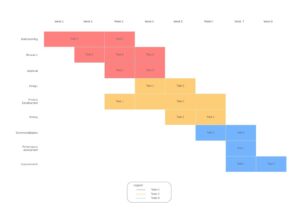
Gnatt chart representing the timetable of the activities planned
You have to create a Gantt chart to represent the activities that are planned for completing this research work within the given time frame. The time frame can change depending on the Univesity’s stipulated guidelines for full-time and part-time Ph.D. programs.
The chart is divided into five different stages, which are:
- Completion of the Course Work: You need to complete the coursework papers as per University Guidelines. This stage is expected to take 12 months.
- Literature review: In this stage, we will review and analyze the existing literature to identify gaps and limitations in the research. This stage is expected to take 06 months.
- Data collection: In this stage, we will collect the required data by conducting experiments and surveys. This stage is expected to take 06 months.
- Data analysis: In this stage, we will analyze the collected data to draw meaningful insights and conclusions. This stage is expected to take 3 months.
- Model development: In this stage, we will develop the proposed model and implement it. This stage is expected to take 12 months.
- Results and Analysis: In this stage, we will gather the results from various dimensions of the proposed model and analyze them. This stage is expected to take 03 months.
- Writing and submission: In this stage, we will write and submit the final research report and the thesis. This stage is expected to take 06 months.
You have to allocate appropriate time for each stage to complete the work on schedule. You have to keep track of the progress regularly and make necessary adjustments to the plan to ensure the timely completion of the research work.
In this section, you have to discuss some potential challenges which you may encounter during your research and how you plan to address them.
Potential Challenges:
- Access to data: Since we are planning to collect data from several sources, it may be challenging to obtain access to all the necessary data.
- Time constraints: We have a strict timeline to follow, and any delays could affect the overall success of the project.
- Technical difficulties: There is always a risk of encountering technical difficulties during data collection or analysis.
Addressing the Challenges:
- Data access: We will communicate with the relevant authorities and request access to the data needed for our research. We will also explore alternative sources of data if necessary.
- Time constraints: We will break down our research into smaller, more manageable tasks and allocate sufficient time for each. We will also build in extra time in case of unexpected delays.
- Technical difficulties: We will test our data collection and analysis tools thoroughly beforehand to minimize the risk of technical difficulties. We will also have contingency plans in place in case of any issues that may arise.
By identifying potential challenges and having a plan in place to address them, you can ensure that your research progresses smoothly and efficiently.
In conclusion, this presentation has outlined a research proposal for a comparative study of deep learning techniques for image recognition in medical imaging. The key points covered in this presentation are:
- The importance of developing accurate and efficient image recognition techniques for medical imaging, which can assist in the diagnosis and treatment of various medical conditions
- A review of the relevant literature in this field has identified the need for further research to compare the performance of different deep-learning techniques for image recognition in medical imaging
- The research problem, objectives, and research question, aim to address this need by comparing the performance of different deep-learning techniques for image recognition in medical imaging
- The study design and methods, which will involve collecting and analyzing medical imaging data using various deep-learning techniques
- The predicted outcomes of the study, which could contribute to improving the accuracy and efficiency of image recognition in medical imaging
- The resources required to complete the study, including access to medical imaging data and computational resources
- The potential societal impact of the study, which could benefit patients and healthcare providers by improving the accuracy and efficiency of medical imaging
- The timetable of activities, which has been represented in a Gantt chart to ensure that the study is completed on schedule
- The potential challenges that may be encountered during the research, and the strategies that will be used to address these challenges.
Overall, this research proposal has the potential to contribute to the field of medical imaging by providing valuable insights into the performance of different deep-learning techniques for image recognition. By improving the accuracy and efficiency of image recognition in medical imaging, this research could ultimately benefit patients and healthcare providers.
Download the PhD Proposal Presentation Template here:
Recent posts.
- Best 5 Journals for Quick Review and High Impact in August 2024
- 05 Quick Review, High Impact, Best Research Journals for Submissions for July 2024
- Top Mistakes to Avoid When Writing a Research Paper
- Average Stipend for Research/Academic Internships
- These Institutes Offer Remote Research/Academic Internships
- All Blog Posts
- Research Career
- Research Conference
- Research Internship
- Research Journal
- Research Tools
- Uncategorized
- Research Conferences
- Research Journals
- Research Grants
- Internships
- Research Internships
- Email Templates
- Conferences
- Blog Partners
- Privacy Policy
Copyright © 2024 Research Voyage
Design by ThemesDNA.com
- eSignatures
- Product updates
- Document templates
How to nail your PhD proposal and get accepted
Bethany Fagan Head of Content Marketing at PandaDoc
Reviewed by:
Olga Asheychik Senior Web Analytics Manager at PandaDoc
- Copy Link Link copied
A good PhD research proposal may be the deciding factor between acceptance and approval into your desired program or finding yourself back at the drawing board. Being accepted for a PhD placement is no easy task, and this is why your PhD proposal needs to truly stand out among a sea of submissions.
That’s why a PhD research proposal is important: It formally outlines the intended research, including methodology, timeline, feasibility, and many other factors that need to be taken into consideration.
Here is a closer look at the PhD proposal process and what it should look like.
→DOWNLOAD NOW: FREE PHD PROPOSAL TEMPLATE
Key takeaways
- A PhD proposal summarizes the research project you intend to conduct as part of your PhD program.
- These proposals are relatively short (1000-2000 words), and should include all basic information and project goals, including the methodologies/strategies you intend to use in order to accomplish them.
- Formats are varied. You may be able to create your own formats, but your college or university may have a required document structure that you should follow.
What is a PhD proposal?
In short, a PhD research proposal is a summary of the project you intend to undertake as part of your PhD program.
It should pose a specific question or idea, make a case for the research, and explain the predicted outcomes of that research.
However, while your PhD proposal may predict expected outcomes, it won’t fully answer your questions for the reader.
Your research into the topic will provide that answer.
Usually, a PhD proposal contains the following elements:
- A clear question that you intend to answer through copious amounts of study and research.
- Your plan to answer that question, including any methodologies, frameworks, and resources required to adequately find the answer.
- Why your question or project is significant to your specific field of study.
- How your proposal impacts, challenges, or improves the existing body of knowledge around a given topic.
- Why your work is important and why you should be the one to receive this opportunity.
In terms of length when writing a PhD proposal, there isn’t a universal answer.
Some institutions will require a short, concise proposal (1000 words), while others allow for a greater amount of flexibility in the length and format of the proposal.
Fortunately, most institutions will provide some guidelines regarding the format and length of your research proposal, so you should have a strong idea of your requirements before you begin.
Benefits of a strong PhD application
While the most obvious benefit of having a strong PhD application is being accepted to the PhD program , there are other reasons to build the strongest PhD application you can:
Better funding opportunities
Many PhD programs offer funding to students , which can be used to cover tuition fees and may provide a stipend for living expenses.
The stronger your PhD application, the better your chances of being offered funding opportunities that can alleviate financial burdens and allow you to focus on your research.
Enhanced academic credentials
A strong PhD application, particularly in hot-button areas of study, can lead to better career opportunities in academics or across a variety of industries.
Opportunities for networking and research
Research proposals that are very well grounded can provide footholds to networking opportunities and mentorships that would not be otherwise available.
However, creating an incredible proposal isn’t always easy.
In fact, it’s easy to get confused by the process since it requires a lot of procedural information.
Many institutions also place a heavy emphasis on using the correct proposal structure.
That doesn’t have to be the issue, though.
Often, pre-designed templates, like the PandaDoc research proposal templates or PhD proposal templates provided by the institution of your choice, can do most of the heavy lifting for you.
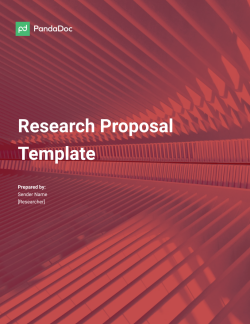
Research Proposal Template
Used 7990 times
4.3 rating (24 reviews)
Reviewed by Olga Asheychik
How to write a Phd proposal with a clear structure
We know that the prospect of writing a research proposal for PhD admission may appear the stuff of nightmares. Even more so if you are new to producing a piece such as this.
But, when you get down to the nitty gritty of what it is, it really isn’t so intimidating. When writing your PhD proposal you need to show that your PhD is worth it, achievable, and that you have the ability to do it at your chosen university.
With all of that in mind, let’s take a closer look at each section of a standard PhD research proposal and the overall structure.
1. Front matter
The first pages of your PhD proposal should outline the basic information about the project. That will include each of the following:
Project title
Typically placed on the first page, your title should be engaging enough to attract attention and clear enough that readers will understand what you’re trying to achieve.
Many proposals also include a secondary headline to further (concisely) clarify the main concept.
Contact information
Depending on the instructions provided by your institution, you may need to include your basic contact information with your proposal.
Some institutions may ask for blind submissions and ask that you omit identifying information, so check the program guidelines to be sure.
Research supervisor
If you already have a supervisor for the project, you’ll typically want to list that information.
Someone who is established in the field can add credibility to your proposal, particularly if your project requires extensive funding or has special considerations.
The guidelines from your PhD program should provide some guidance regarding any other auxiliary information that you should add to the front of your proposal.
Be sure to check all documentation to ensure that everything fits into the designated format.
2. Goals, summaries, and objectives
Once you’ve added the basic information to your document, you’ll need to get into the meat of your PhD proposal.
Depending on your institution, your research proposal may need to follow a rigid format or you may have the flexibility to add various sections and fully explain your concepts.
These sections will primarily be focused on providing high-level overviews surrounding your PhD proposal, including most of the following:
Overall aims, objectives, and goals
In these sections, you’ll need to state plainly what you aim to accomplish with your PhD research.
If awarded funding, what questions will your PHd proposal seek to answer? What theories will you test? What concepts will you explore in your research?
Briefly, how would you summarize your approach to this project?
Provide high-level summaries detailing how you mean to achieve your answers, what the predicted outcomes of your PhD research might be, and precisely what you intend to test or discover.
Significance
Why does your research matter? Unlike with many other forms of academic study (such as a master’s thesis ), doctorate-level research often pushes the bounds of specific fields or contributes to a given body of work in some unique way.
How will your proposed PhD research do those things?
Background details
Because PhD research is about pushing boundaries, adding background context regarding the current state of affairs in your given field can help readers better understand why you want to pursue this research and how you arrived at this specific point of interest.
While the information here may (or may not) be broken into multiple sections, the content here is largely designed to provide a high-level overview of your PhD proposal and entice readers to dig deeper into the methodologies and angles of approach in future sections.
Because so much of this section relies on the remainder of your document, it’s sometimes better to skip this portion of the PhD proposal until the later sections are complete and then circle back to it.
That way, you can provide concise summaries that refer to fully defined research methods that you’ve already explained in subsequent areas.
3. Methodologies and plans
Unlike a master’s thesis or a similar academic document, PhD research is designed to push the boundaries of its subject matter in some way.
The idea behind doctoral research is to expand the field with new insights and viewpoints that are the culmination of years of research and study, combined with a deep familiarity of the topic at hand.
The methodologies and work plans you provide will give advisors some insights into how you plan to conduct your research.
While there is no one right way to develop this section, you’ll need to include a few key details:
Research methods
Are there specific research methods you plan to use to conduct your PhD research?
Are you conducting experiments? Conducting qualitative research? Surveying specific individuals in a given environment?
Benefits and drawbacks of your approach
Regardless of your approach to your topic, there will be upsides and downsides to that methodology.
Explain what you feel are the primary benefits to your research method, where there are potential flaws, and how you plan to account for those shortfalls.
Choice of methodology
Why did you choose a given methodology?
What makes it the best method (or collection of methods) for your research and/or specific use case?
Outline of proposed work
What work is required for PhD research to be complete?
What steps will you need to take in order to capture the appropriate information? How will you complete those steps?
Schedule of work (including timelines/deadlines)
How long will it take you to complete each stage or step of your project?
If your PhDproject will take several years, you may need to provide specifics for more immediate timelines up front while future deadlines may be flexible or estimated.
There is some flexibility here.
It’s unlikely that your advisors will expect you to have the answer for every question regarding how you plan to approach your body of research.
When trying to push the boundaries of any given topic, it’s expected that some things may not go to plan.
However, you should do your best to make timelines and schedules of work that are consistent with your listed goals.
Remember : At the end of your work, you are expected to have a body of original research that is complete within the scope and limitations of the PhD proposal you set forth.
If your advisors feel that your subject matter is too broad, they may encourage you to narrow the scope to better fit into more standardized expectations.
4. Resources and citations
No PhD research proposal is complete without a full list of the resources required to carry out the project and references to help prove and validate the research.
Here’s a closer look at what you’ll need to submit in order to explain costs and prove the validity of your proposal:
Estimated costs and resources
Most doctoral programs offer some level of funding for these projects.
To take advantage of those funds, you’ll need to submit a budget of estimated costs so that assessors can better understand the financial requirements.
This might include equipment, expenses for fieldwork or travel, and more.
Citations and bibliographies
No matter your field of study, doctoral research is built on the data and observations provided by past contributors.
Because of this, you’ll need to provide citations and sources referenced in your PhD proposal documentation.
Particularly when it comes to finances and funding, it might be tempting to downplay the cost of the project.
However, it’s best to provide a realistic estimate in terms of costs so that you have enough of a budget to cover the PhD research.
Adjustments can be made at a later date, particularly as you conduct more research and dive further into the project.
Resources are often presented in the form of a table to make things easier to track and identify.
| Item | Qty. | Cost | Subtotal | Total |
|---|---|---|---|---|
| Project Allowance | ||||
| Translator | 3 months | $500 | $1,500 | |
| Transportation within state | 3 months | $400 | $1,200 | |
| Interview software | 1 month | $30 | $30 | |
| Recording equipment | 1 | $2,400 | $2,400 | |
| Rent (Nigeria) | 3 months | $400 | $1,200 | |
| Groceries (Nigeria) | 3 months | $500 | $1,500 | |
| $8,100 | ||||
| Jet Travel | ||||
| San Diego – Nigeria (roundtrip) | 6 | $600 | $3,600 | $3,600 |
| Total Project Allowance | $11,700 | |||
| Administrative fees | $240 | |||
| Total Resources | $11,940 |
Using PhD proposal templates
Aside from any guidelines set forth by your institution, there are no particularly strict rules when it comes to the format of PhD proposals.
Your supervisor will be more than capable of guiding you through the process.
However, since everything is so structured and formal, you might want to use a PhD proposal template to help you get started.
Templates can help you stay on track and make sure your research proposal follows a certain logic.
A lot of proposal software solutions offer templates for different types of proposals, including PhD proposals.
But, should you use Phd proposal templates? Here are some pros and cons to help you make a decision.
- Expedites the proposal process.
- Helps you jumpstart the process with a flexible document structure.
- Often provides sections with pre-filled examples.
- Looks better than your average Word document.
- May be limiting if you adhere to it too much.
- Might not be perfectly suited to your specific field of research, requiring some customization.
In our PhD research proposal template , we give you just enough direction to help you follow through but we don’t limit your creativity to a point that you can’t express yourself and all the nuances of your research.
For almost all sections, you get a few useful PhD research proposal examples to point you in the right direction.
The template provides you with a typical PhD proposal structure that’s perfect for almost all disciplines.
It can come in quite handy when you have everything planned out in your head but you’re just having trouble putting it onto the page!
Writing a PhD proposal that convinces
Writing and completing a PhD proposal might be confusing at first.
You need to follow a certain logic and share all the required information without going too long or sharing too much about the project.
And, while your supervisor will certainly be there to guide you, the brunt of the work will still fall on your shoulders.
That’s why you need to stay informed, do your research, and don’t give up until you feel comfortable with what you’ve created.
If you want to get a head start, you might want to consider our research proposal template .
It will offer you a structure to follow when writing a PhD proposal and give you an idea on what to write in each section.
Start your 14 days trial with PandaDoc and check out all the tools you’ll have at your disposal!
Research proposals for PhD admission: tips and advice
One of the most important tips for any piece of writing is to know your audience. The staff reviewing your PhD proposal are going through a pile of them, so you need to make sure yours stands within a few seconds of opening it.
The way to do this is by demonstrating value and impact. Academic work is often written for a niche community of researchers in one field, so you need to demonstrate why your work would be valuable to people in that area.
The people reviewing your proposal will likely be in that field. So your proposal should be a little like a sales pitch: you need to write something engaging that identifies with the “customer”, speaks to a problem they’re having, and shows them a solution.
Taking some inspiration from the former University of Chicago professor Larry McEnerney , here are some ideas to keep in mind…
- It’s common for undergraduates and even seasoned academics to write in a specific format or style to demonstrate their understanding and signal that they’re part of the academic community. Instead, you want to write in such a way that actually engages the reader.
- Identify an uncharted or underexplored knowledge gap in your field, and show the reader you have what it takes to fill in that gap.
- Challenge the status quo. Set up an idea that people in your field take for granted — maybe a famous study you think is flawed — and outline how your project could knock it down.
- This is why it’s important to understand who your audience is. You have to write your proposal in such a way that it’s valuable for reviewers. But within your proposal, you should also clearly define which community of researchers your project is for, what problems they have, and how your project is going to solve those problems.
- Every community of researchers has their own implicit “codes” and “keywords” that signal understanding. These will be very different in each field and could be very subtle. But just by reading successful PhD research proposal examples in your field, you can get a sense of what those are and decide how you want to employ them in your own work.
- In this model authors start “at the bottom of the glass” with a very narrow introduction to the idea of the paper, then “fill the glass” with a broader and broader version of the same idea.
- Instead, follow a “problem-solution” framework. Introduce a problem that’s relevant to your intended reader, then offer a solution. Since “solutions” often raise their own new problems or questions, you can rinse and repeat this framework all the way through any section of your proposal.
But how can you apply that advice? If you’re following something like our research proposal template , here are some actionable ways to get started.
- Your title should be eye-catching , and signal value by speaking to either a gap in the field or challenging the status quo.
- Your abstract should speak to a problem in the field, one the reviewers will care about, and clearly outline how you’d like to solve it.
- When you list the objectives of your proposal , each one should repeat this problem-solution framework. You should concretely state what you want to achieve, and what you’re going to do to achieve it.
- While you survey your chosen field in the literature review, you should refer back to the knowledge gap or status quo that you intend to work on. This reinforces how important your proposed project is, and how valuable it would be to the community if your project was successful.
- While listing your research limitations , try to hint at new territory researchers might be able to explore off the back of your work. This illustrates that you’re proposing boundary-pushing work that will really advance knowledge of the field.
- While you’re outlining your funding requirements , be clear about why each line item is necessary and bring it back to the value of your proposed research. Every cent counts!
Frequently asked questions
How long should a phd proposal be.
There really isn’t a specific rule when it comes to the length of a PhD proposal. However, it’s generally accepted that it should be between 1,000 and 2,000 words.
It’s difficult to elaborate on such a serious project in less than 1,000 words but going over 2,000 is often overkill. You’ll lose people’s attention and water down your points.
What’s the difference between a dissertation proposal and a PhD proposal?
There seems to be some confusion over the terms “dissertation” and “PhD” and how you write proposals for each one. However, “dissertation” is just another name for your PhD research so the proposal for a dissertation would be the same since it’s quite literally the same thing.
Does a PhD proposal include budgeting?
Yes, as mentioned, you need to demonstrate the feasibility of your project within the given time frame and with the resources you need, including budgets. You don’t need to be exact, but you need to have accurate estimates for everything.
How is a PhD proposal evaluated?
This will change from one institution to another but these things will generally have a big impact on the reviewers:
- The contribution of the project to the field.
- Design and feasibility of the project.
- The validity of the methodology and objectives.
- The supervisor and their role in the field.
PandaDoc is not a law firm, or a substitute for an attorney or law firm. This page is not intended to and does not provide legal advice. Should you have legal questions on the validity of e-signatures or digital signatures and the enforceability thereof, please consult with an attorney or law firm. Use of PandaDocs’ services are governed by our Terms of Use and Privacy Policy.
Originally published June 9, 2023, updated February 6, 2024
Related articles

Proposals 24 min

Sales 5 min

Document templates 13 min

- PowerPoint Templates
17 Free Research Proposal PowerPoint Templates for Scientific Project, Thesis Defence
Are you a scientist who wishes to create a research proposal presentation in the best manner? If you do, then this excellent list of Research Proposal PowerPoint Templates is truly a demand!
The research proposal is a document that a researcher needs to write, It outlines the details of a research project and gives team members or readers a summary of the information in a project.
In order to allow readers to understand the project information more clearly, a research proposal presentation will be a better way to present the information of a research project.
A research proposal PPT should include the following:
- Research title or topic: make sure your title can clearly describe the research project, or supplement your research project with a short statement.
- Research background: why do this research project
- literature review: describe research progress on your research topic, and the gap or remaining questions need to research.
- Research aim, objective, and hypothesis
- Research method: explain how to conduct your research, how data is collected and analyzed.
- Results: the results you expect.
- Question: provides an overview of the problems encountered during the research process, and how to solve them.
- Summary: make sure the reader has a complete understanding of your research project.
Note: this PDF file made by Australian National University provides more information about the research proposal presentation.
In this collection, you’ll find numerous and diverse styles of research proposals ppt templates that you can pick as part of your inspiration.
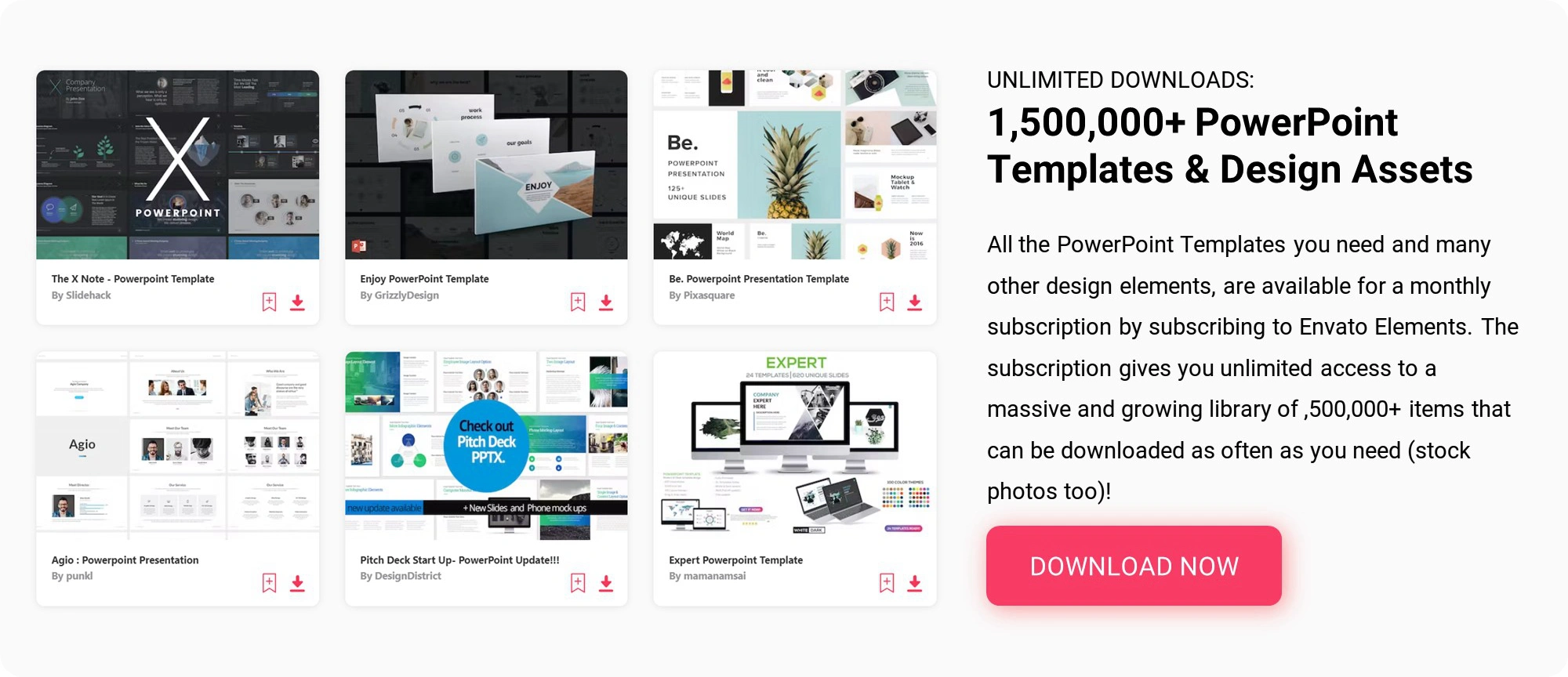
Table of Contents
Free research proposal powerpoint templates, premium research proposal powerpoint templates, 1. rea thesis presentation template.
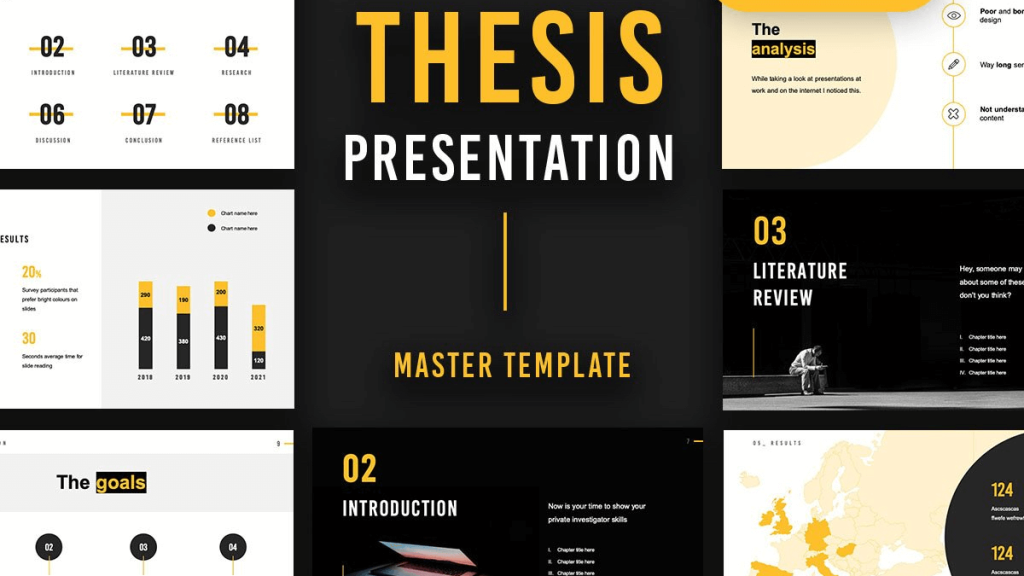
You can create a professional research proposal with Rea in a matter of minutes. Why? Because you don’t need any design knowledge or sophisticated design software like Photoshop or Adobe Illustrator, the Rea ppt template gives you everything you need to create a research proposal, it provides a complete pre-built slide set. What you need to do is focus on your study.
To assist you in presenting your research proposal in a structured way, the Rea template divides your research proposal into seven sections: introduction, literature review, research, results, discussion, conclusion, reference list. The majority of research proposals can follow this structure.
The Rea ppt template features a modern, creative design, the alternation of light slides and dark slides will attract the viewer’s attention well.
Unique slides: 33
2. Master Thesis Defense PowerPoint Template
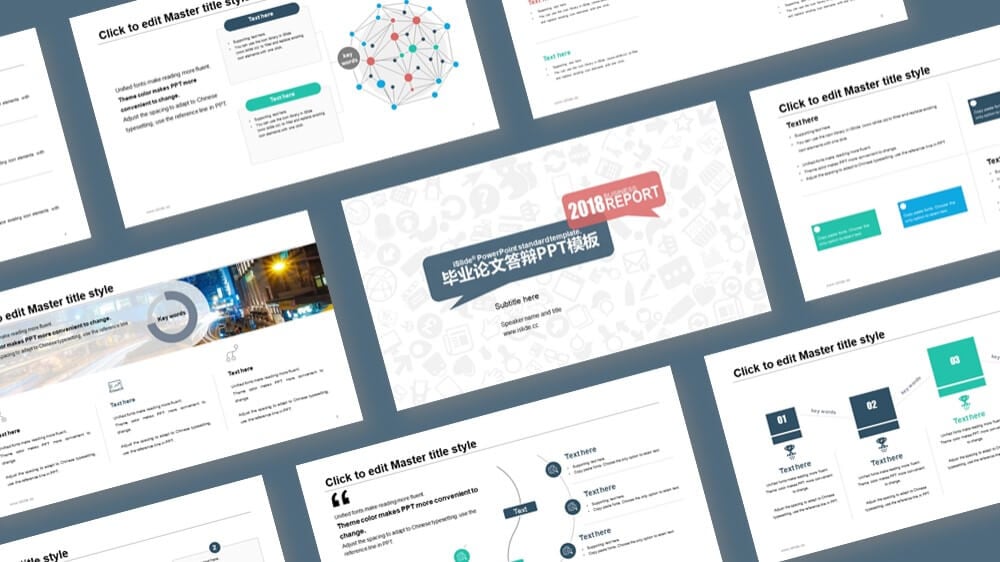
The Master Thesis Defense PowerPoint Template is a thesis PowerPoint presentation for students. It features a clean, sophisticated design, the unified layout allows you to easily adjust or add slides in your presentation. This template is perfect for a master’s thesis.
Unique slides: 21
3. Blue Graduation & Thesis Defense Presentation
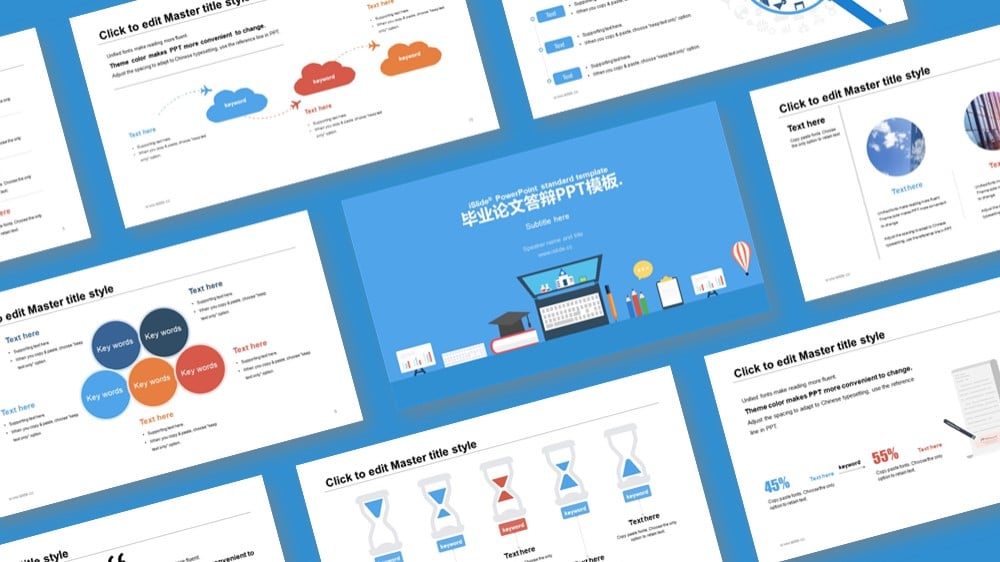
This PPT template is made for thesis defense presentations, such as bachelors thesis, PhD thesis, masters thesis, or doctoral thesis. It comes with a blue background cover slide and a lot of useful infographic slides.
4. Red Dissertation proposal defense powerpoint presentation

This research proposal PowerPoint template uses a striking red as the main color, features 21 editable slides. The table of contents slide and break slide will help you organize your content.
5. Green Dissertation defense presentation template

Green Dissertation defense presentation template comes with 21 unique slides and a clean layout, suited for chemistry thesis or biology thesis.
6. PhD Dissertation Defense Presentation Template

PhD Dissertation Defense Presentation Template features a clean, minimal design. It’s well organized and easy to use. The only thing you need to focus on is your research.
7. Blue Medical research proposal powerpoint template

Blue Medical is a free multipurpose PowerPoint template for medical presentations. This template is also perfect for medical research proposals, chemical project research proposals.
Unique slides: 41
8. Master’s Thesis Defense PowerPoint Template

Master’s Thesis Defense Free PowerPoint Template is one of the best research proposal templates. You don’t need to build anything from scratch, it’s more or less just a matter of dragging and dropping, editing text and charts.
Unique slides: 28
9. Research presentation Template

This PPT template is a simple alternative that helps you create a research slide. It includes 5 steps to guide you through the research process. If you want a simplest PowerPoint template, this will be the right one.
Unique slides: 9
10. Minerva Master Thesis Defense PowerPoint Template

Minerva is a free minimalist master’s thesis defense presentation template. It has 34 comprehensive and unique slides. Use this template to present your research now!
Unique slides: 34
11. Professional Thesis Project Proposal PowerPoint Template
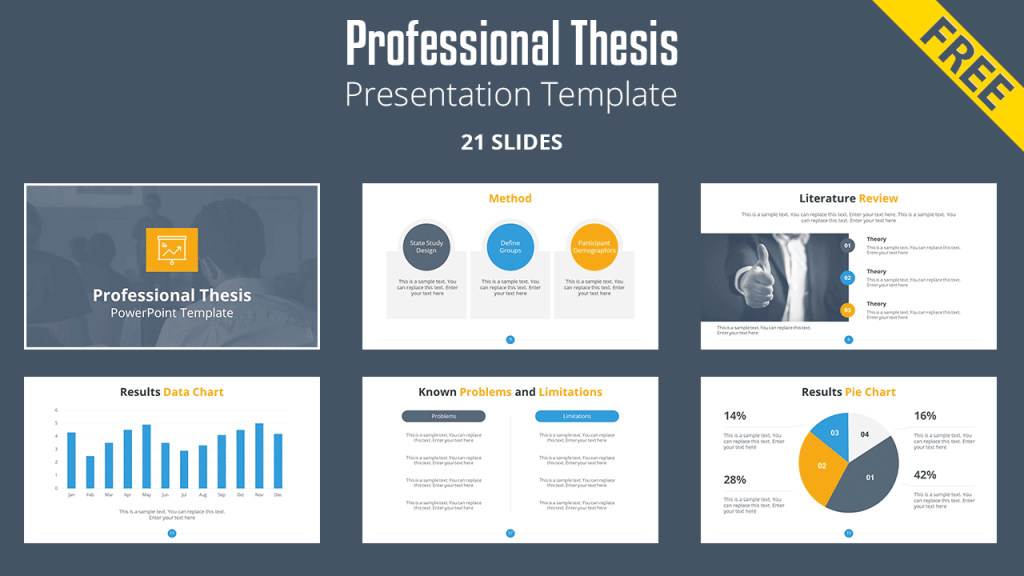
Professional Thesis Project Proposal PowerPoint Template is a free research paper ppt template. It comes with 21 easy-to-use slides that include every aspect of your thesis, from the purpose of your study to method, data analysis, results, and discussion.
12. Thesis Presentation Powerpoint & Google Slides Template
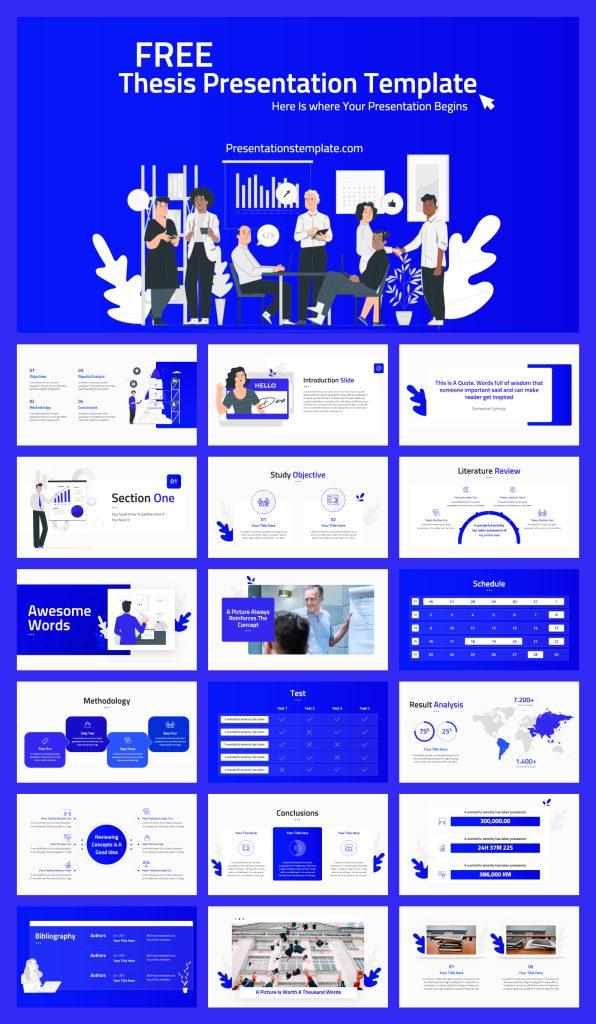
This presentation template is one of the best free research proposal ppt templates that help you stand out. It features 20 pre-built research slides with modern, minimal layouts.
13. The effects of technology learning Research Presentation Template

This cool presentation template is designed for students to present their school projects. It includes many illustrations and graphs.
14. Free Thesis Defense Presentation Template
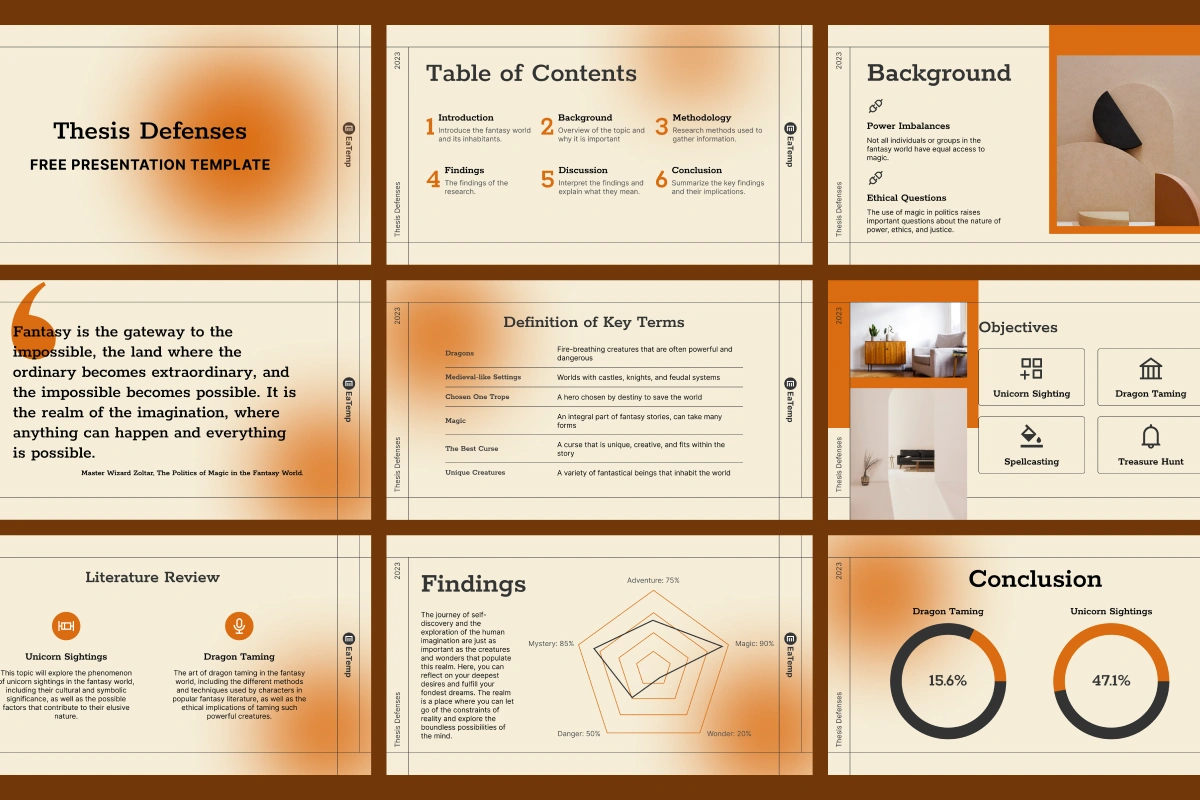
This beautiful PPT template is for anyone who needs a quick but professional thesis defense template. Utilize professionally designed slides for your introduction, methodology, results, and conclusion. The template includes 22 animated slides.
15. Black and white Research Proposal Presentation Free download

A free research proposal presentation template for PowerPoint and Google Slides, contains 29 unique slides.
16. Simple Research Proposal Presentation
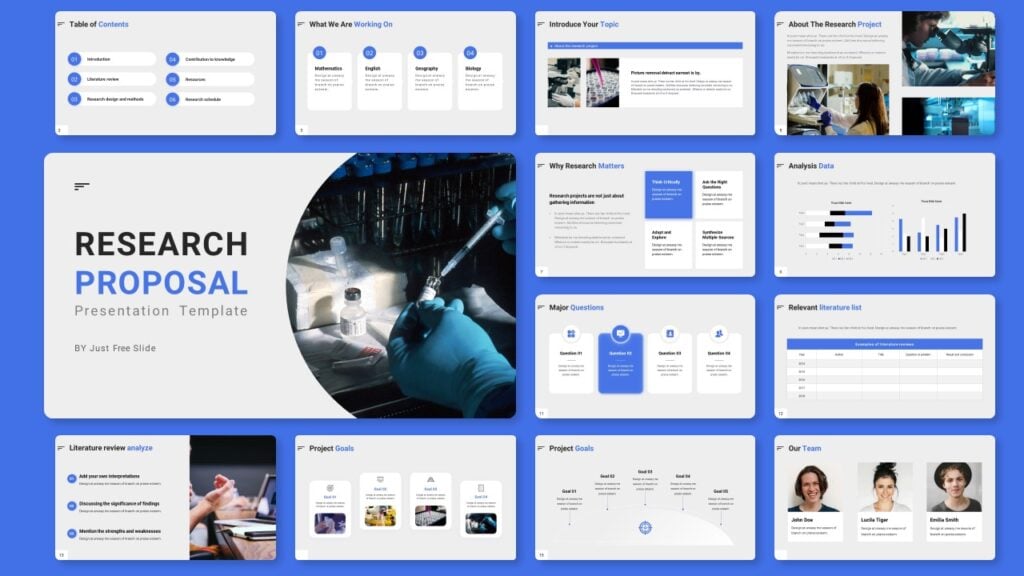
The template comes with a simple, minimal, and modern design. It would be perfect for any type of research proposal.
17. Glassmorphism Thesis Defense PPT Presentation
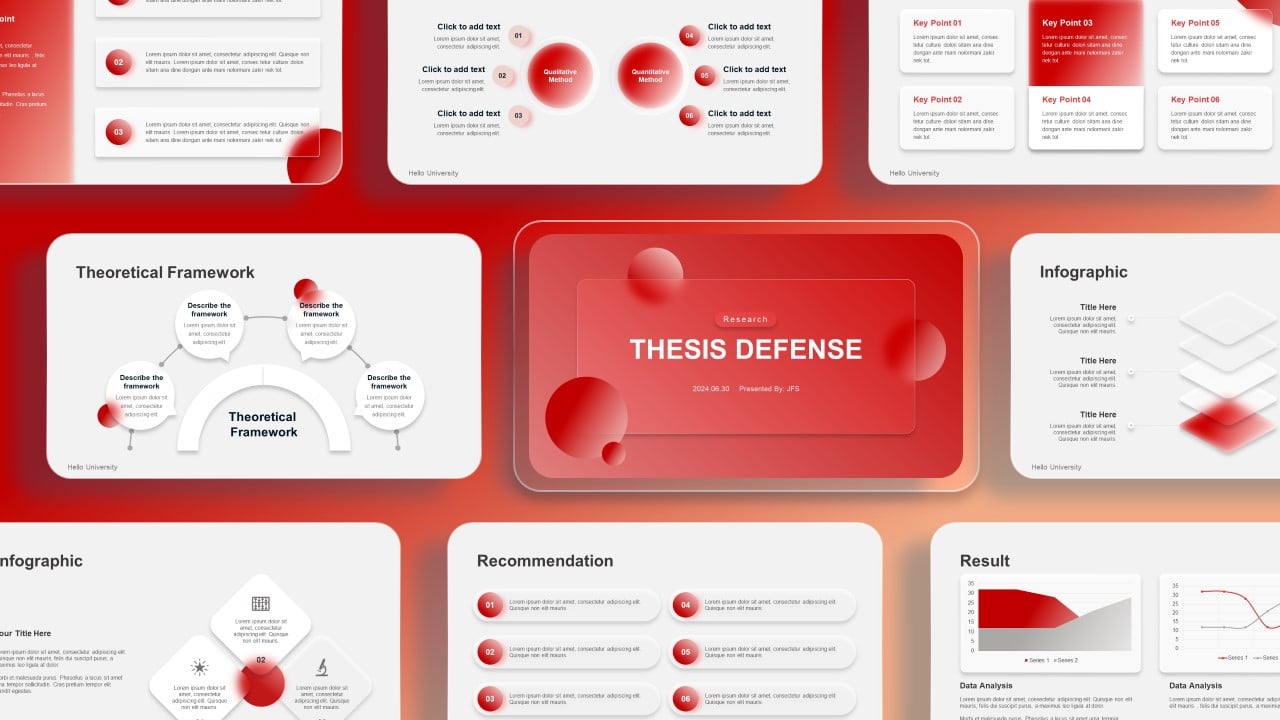
Another thesis proposal powerpoint template with aesthetic glassmorphism design. It comes with 27 unique slides for thesis defense or thesis proposal presentation.
Thesis Science Powerpoint Template

Thesis Science Powerpoint Template offers 20 unique slides. All slides have been organized and categorized to adhere to the guidelines stipulated by the thesis defense format.
SOLOZ – Dark Background Science Thesis Defense Powerpoint Template
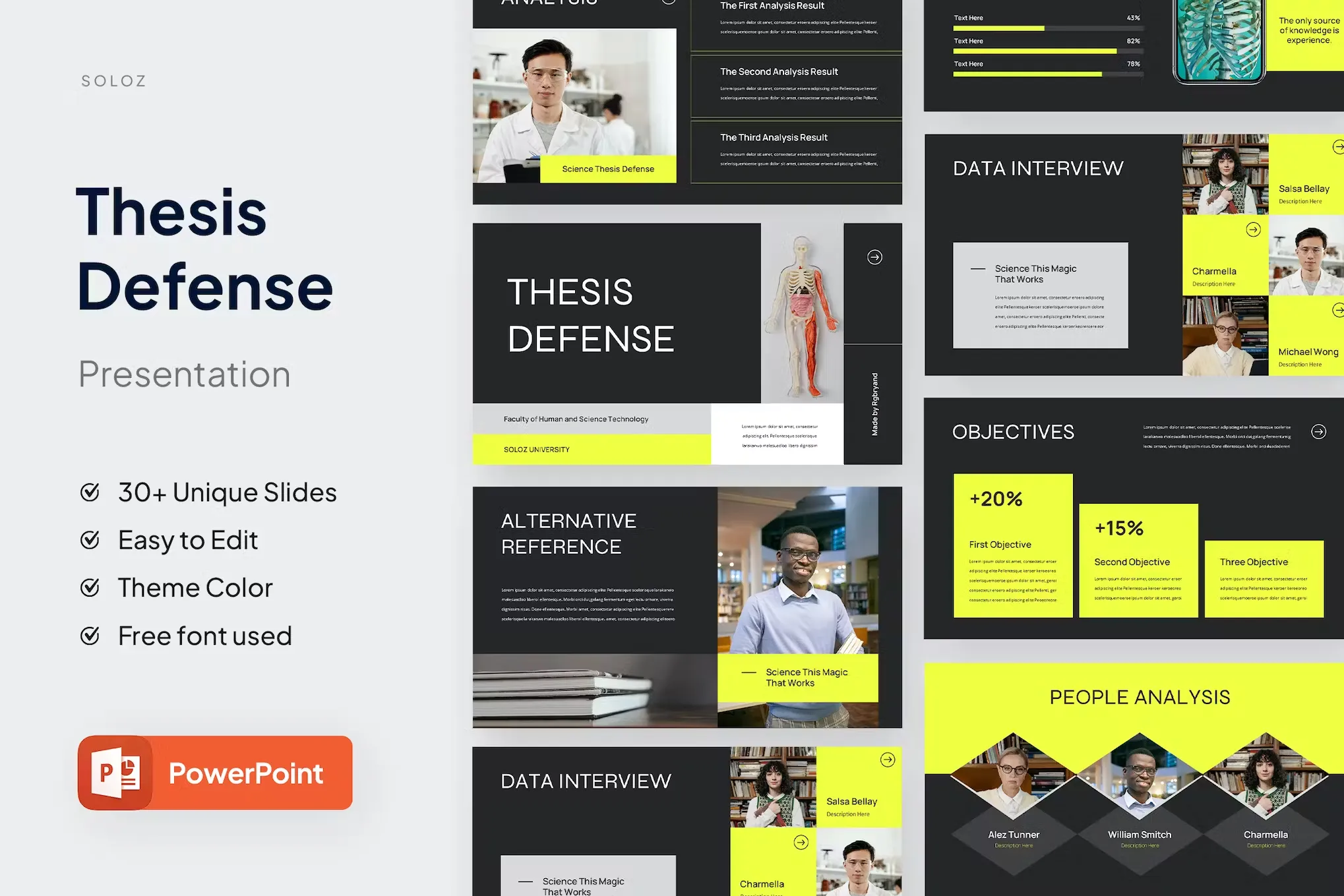
SOLOZ PPT template contains 30 unique slides with a dark background. The unified color scheme and master slides make it easy to customize and quickly build an impressive presentation.
Thesis Defense – Design Powerpoint Template

This thesis defense PowerPoint template uses a design interior theme as a preview. It comes with 30 unique slides, dark and light backgrounds, and widescreen & standard ratio.
Research Proposal PPT Template

The Research Proposal PowerPoint Template offers over 50 slide designs with a modern and professional look. This template is available in three various formats: PowerPoint, Google Slides, and Keynote.
Thank you for visiting Just Free Slide and reading this article! We hope this article helped you find the best research proposal PowerPoint template. We highly appreciate it! Now you might want to get more free PowerPoint templates . Below you’ll find more PowerPoint templates related to the research proposal:
- 8 Best Academic PowerPoint Templates
- 42 Pages Thesis Defense PowerPoint Presentation Template (Premium)
More like this

Wonderful article! I have found an amazing site on Google it’s http://www.kridha.net . Here you can explore professionally designed fully customizable research templates which are easy to use.
Leave a Reply Cancel reply
Your email address will not be published. Required fields are marked *

Research Proposal Example/Sample
Detailed Walkthrough + Free Proposal Template
If you’re getting started crafting your research proposal and are looking for a few examples of research proposals , you’ve come to the right place.
In this video, we walk you through two successful (approved) research proposals , one for a Master’s-level project, and one for a PhD-level dissertation. We also start off by unpacking our free research proposal template and discussing the four core sections of a research proposal, so that you have a clear understanding of the basics before diving into the actual proposals.
- Research proposal example/sample – Master’s-level (PDF/Word)
- Research proposal example/sample – PhD-level (PDF/Word)
- Proposal template (Fully editable)
If you’re working on a research proposal for a dissertation or thesis, you may also find the following useful:
- Research Proposal Bootcamp : Learn how to write a research proposal as efficiently and effectively as possible
- 1:1 Proposal Coaching : Get hands-on help with your research proposal

PS – If you’re working on a dissertation, be sure to also check out our collection of dissertation and thesis examples here .
FAQ: Research Proposal Example
Research proposal example: frequently asked questions, are the sample proposals real.
Yes. The proposals are real and were approved by the respective universities.
Can I copy one of these proposals for my own research?
As we discuss in the video, every research proposal will be slightly different, depending on the university’s unique requirements, as well as the nature of the research itself. Therefore, you’ll need to tailor your research proposal to suit your specific context.
You can learn more about the basics of writing a research proposal here .
How do I get the research proposal template?
You can access our free proposal template here .
Is the proposal template really free?
Yes. There is no cost for the proposal template and you are free to use it as a foundation for your research proposal.
Where can I learn more about proposal writing?
For self-directed learners, our Research Proposal Bootcamp is a great starting point.
For students that want hands-on guidance, our private coaching service is recommended.

Psst… there’s more!
This post is an extract from our bestselling short course, Research Proposal Bootcamp . If you want to work smart, you don't want to miss this .
14 Comments
I am at the stage of writing my thesis proposal for a PhD in Management at Altantic International University. I checked on the coaching services, but it indicates that it’s not available in my area. I am in South Sudan. My proposed topic is: “Leadership Behavior in Local Government Governance Ecosystem and Service Delivery Effectiveness in Post Conflict Districts of Northern Uganda”. I will appreciate your guidance and support
GRADCOCH is very grateful motivated and helpful for all students etc. it is very accorporated and provide easy access way strongly agree from GRADCOCH.
Proposal research departemet management
I am at the stage of writing my thesis proposal for a masters in Analysis of w heat commercialisation by small holders householdrs at Hawassa International University. I will appreciate your guidance and support
please provide a attractive proposal about foreign universities .It would be your highness.
comparative constitutional law
Kindly guide me through writing a good proposal on the thesis topic; Impact of Artificial Intelligence on Financial Inclusion in Nigeria. Thank you
Kindly help me write a research proposal on the topic of impacts of artisanal gold panning on the environment
I am in the process of research proposal for my Master of Art with a topic : “factors influence on first-year students’s academic adjustment”. I am absorbing in GRADCOACH and interested in such proposal sample. However, it is great for me to learn and seeking for more new updated proposal framework from GRADCAOCH.
Kindly help me write a research proposal on the effectiveness of junior call on prevention of theft
kindly assist me in writing the proposal in psychology education
Please,Kindly assist my in my phd thesis writing on personal and socio cultural factors as determinate of family planning adoption
I’m interested to apply for a mhil program in crop production. Please need assistance in proposal format.
Submit a Comment Cancel reply
Your email address will not be published. Required fields are marked *
Save my name, email, and website in this browser for the next time I comment.
- Print Friendly

PhD Dissertation Defense Slides Design: Example slides
- Tips for designing the slides
- Presentation checklist
- Example slides
- Additional Resources
Acknowledgments
Thank all ph.d.s for sharing their presentations. if you are interested in sharing your slides, please contact julie chen ([email protected])., civil and environmental engineering.
- Carl Malings (2017)
- Irem Velibeyoglu (2018)
- Chelsea Kolb (2018)
- I. Daniel Posen (2016)
- Kerim Dickson (2018)
- Lauren M. Cook (2018)
- Xiaoju Chen (2017)
- Wei Ma (2019)
- Miranda Gorman (2019)
- Tim Bartholomew (2019)
- << Previous: Presentation checklist
- Next: Additional Resources >>
- Last Updated: Jan 9, 2024 11:18 AM
- URL: https://guides.library.cmu.edu/c.php?g=883178
How to write a research proposal
What is a research proposal.
A research proposal should present your idea or question and expected outcomes with clarity and definition – the what.
It should also make a case for why your question is significant and what value it will bring to your discipline – the why.
What it shouldn't do is answer the question – that's what your research will do.
Why is it important?
Research proposals are significant because Another reason why it formally outlines your intended research. Which means you need to provide details on how you will go about your research, including:
- your approach and methodology
- timeline and feasibility
- all other considerations needed to progress your research, such as resources.
Think of it as a tool that will help you clarify your idea and make conducting your research easier.
How long should it be?
Usually no more than 2000 words, but check the requirements of your degree, and your supervisor or research coordinator.
Presenting your idea clearly and concisely demonstrates that you can write this way – an attribute of a potential research candidate that is valued by assessors.
What should it include?
Project title.
Your title should clearly indicate what your proposed research is about.
Research supervisor
State the name, department and faculty or school of the academic who has agreed to supervise you. Rest assured, your research supervisor will work with you to refine your research proposal ahead of submission to ensure it meets the needs of your discipline.
Proposed mode of research
Describe your proposed mode of research. Which may be closely linked to your discipline, and is where you will describe the style or format of your research, e.g. data, field research, composition, written work, social performance and mixed media etc.
This is not required for research in the sciences, but your research supervisor will be able to guide you on discipline-specific requirements.
Aims and objectives
What are you trying to achieve with your research? What is the purpose? This section should reference why you're applying for a research degree. Are you addressing a gap in the current research? Do you want to look at a theory more closely and test it out? Is there something you're trying to prove or disprove? To help you clarify this, think about the potential outcome of your research if you were successful – that is your aim. Make sure that this is a focused statement.
Your objectives will be your aim broken down – the steps to achieving the intended outcome. They are the smaller proof points that will underpin your research's purpose. Be logical in the order of how you present these so that each succeeds the previous, i.e. if you need to achieve 'a' before 'b' before 'c', then make sure you order your objectives a, b, c.
A concise summary of what your research is about. It outlines the key aspects of what you will investigate as well as the expected outcomes. It briefly covers the what, why and how of your research.
A good way to evaluate if you have written a strong synopsis, is to get somebody to read it without reading the rest of your research proposal. Would they know what your research is about?
Now that you have your question clarified, it is time to explain the why. Here, you need to demonstrate an understanding of the current research climate in your area of interest.
Providing context around your research topic through a literature review will show the assessor that you understand current dialogue around your research, and what is published.
Demonstrate you have a strong understanding of the key topics, significant studies and notable researchers in your area of research and how these have contributed to the current landscape.
Expected research contribution
In this section, you should consider the following:
- Why is your research question or hypothesis worth asking?
- How is the current research lacking or falling short?
- What impact will your research have on the discipline?
- Will you be extending an area of knowledge, applying it to new contexts, solving a problem, testing a theory, or challenging an existing one?
- Establish why your research is important by convincing your audience there is a gap.
- What will be the outcome of your research contribution?
- Demonstrate both your current level of knowledge and how the pursuit of your question or hypothesis will create a new understanding and generate new information.
- Show how your research is innovative and original.
Draw links between your research and the faculty or school you are applying at, and explain why you have chosen your supervisor, and what research have they or their school done to reinforce and support your own work. Cite these reasons to demonstrate how your research will benefit and contribute to the current body of knowledge.

Proposed methodology
Provide an overview of the methodology and techniques you will use to conduct your research. Cover what materials and equipment you will use, what theoretical frameworks will you draw on, and how will you collect data.
Highlight why you have chosen this particular methodology, but also why others may not have been as suitable. You need to demonstrate that you have put thought into your approach and why it's the most appropriate way to carry out your research.
It should also highlight potential limitations you anticipate, feasibility within time and other constraints, ethical considerations and how you will address these, as well as general resources.
A work plan is a critical component of your research proposal because it indicates the feasibility of completion within the timeframe and supports you in achieving your objectives throughout your degree.
Consider the milestones you aim to achieve at each stage of your research. A PhD or master's degree by research can take two to four years of full-time study to complete. It might be helpful to offer year one in detail and the following years in broader terms. Ultimately you have to show that your research is likely to be both original and finished – and that you understand the time involved.
Provide details of the resources you will need to carry out your research project. Consider equipment, fieldwork expenses, travel and a proposed budget, to indicate how realistic your research proposal is in terms of financial requirements and whether any adjustments are needed.
Bibliography
Provide a list of references that you've made throughout your research proposal.
Apply for postgraduate study
New hdr curriculum, find a supervisor.
Search by keyword, topic, location, or supervisor name
- 1800 SYD UNI ( 1800 793 864 )
- or +61 2 8627 1444
- Open 9am to 5pm, Monday to Friday
- Student Centre Level 3 Jane Foss Russell Building Darlington Campus
Scholarships
Find the right scholarship for you
Research areas
Our research covers the spectrum – from linguistics to nanoscience
Our breadth of expertise across our faculties and schools is supported by deep disciplinary knowledge. We have significant capability in more than 20 major areas of research.
Research facilities
High-impact research through state-of-the-art infrastructure
Have a language expert improve your writing
Run a free plagiarism check in 10 minutes, generate accurate citations for free.
- Knowledge Base
- Starting the research process
- How to Write a Research Proposal | Examples & Templates
How to Write a Research Proposal | Examples & Templates
Published on October 12, 2022 by Shona McCombes and Tegan George. Revised on November 21, 2023.

A research proposal describes what you will investigate, why it’s important, and how you will conduct your research.
The format of a research proposal varies between fields, but most proposals will contain at least these elements:
Introduction
Literature review.
- Research design
Reference list
While the sections may vary, the overall objective is always the same. A research proposal serves as a blueprint and guide for your research plan, helping you get organized and feel confident in the path forward you choose to take.
Table of contents
Research proposal purpose, research proposal examples, research design and methods, contribution to knowledge, research schedule, other interesting articles, frequently asked questions about research proposals.
Academics often have to write research proposals to get funding for their projects. As a student, you might have to write a research proposal as part of a grad school application , or prior to starting your thesis or dissertation .
In addition to helping you figure out what your research can look like, a proposal can also serve to demonstrate why your project is worth pursuing to a funder, educational institution, or supervisor.
| Show your reader why your project is interesting, original, and important. | |
| Demonstrate your comfort and familiarity with your field. Show that you understand the current state of research on your topic. | |
| Make a case for your . Demonstrate that you have carefully thought about the data, tools, and procedures necessary to conduct your research. | |
| Confirm that your project is feasible within the timeline of your program or funding deadline. |
Research proposal length
The length of a research proposal can vary quite a bit. A bachelor’s or master’s thesis proposal can be just a few pages, while proposals for PhD dissertations or research funding are usually much longer and more detailed. Your supervisor can help you determine the best length for your work.
One trick to get started is to think of your proposal’s structure as a shorter version of your thesis or dissertation , only without the results , conclusion and discussion sections.
Download our research proposal template
Prevent plagiarism. Run a free check.
Writing a research proposal can be quite challenging, but a good starting point could be to look at some examples. We’ve included a few for you below.
- Example research proposal #1: “A Conceptual Framework for Scheduling Constraint Management”
- Example research proposal #2: “Medical Students as Mediators of Change in Tobacco Use”
Like your dissertation or thesis, the proposal will usually have a title page that includes:
- The proposed title of your project
- Your supervisor’s name
- Your institution and department
The first part of your proposal is the initial pitch for your project. Make sure it succinctly explains what you want to do and why.
Your introduction should:
- Introduce your topic
- Give necessary background and context
- Outline your problem statement and research questions
To guide your introduction , include information about:
- Who could have an interest in the topic (e.g., scientists, policymakers)
- How much is already known about the topic
- What is missing from this current knowledge
- What new insights your research will contribute
- Why you believe this research is worth doing
Receive feedback on language, structure, and formatting
Professional editors proofread and edit your paper by focusing on:
- Academic style
- Vague sentences
- Style consistency
See an example

As you get started, it’s important to demonstrate that you’re familiar with the most important research on your topic. A strong literature review shows your reader that your project has a solid foundation in existing knowledge or theory. It also shows that you’re not simply repeating what other people have already done or said, but rather using existing research as a jumping-off point for your own.
In this section, share exactly how your project will contribute to ongoing conversations in the field by:
- Comparing and contrasting the main theories, methods, and debates
- Examining the strengths and weaknesses of different approaches
- Explaining how will you build on, challenge, or synthesize prior scholarship
Following the literature review, restate your main objectives . This brings the focus back to your own project. Next, your research design or methodology section will describe your overall approach, and the practical steps you will take to answer your research questions.
| ? or ? , , or research design? | |
| , )? ? | |
| , , , )? | |
| ? |
To finish your proposal on a strong note, explore the potential implications of your research for your field. Emphasize again what you aim to contribute and why it matters.
For example, your results might have implications for:
- Improving best practices
- Informing policymaking decisions
- Strengthening a theory or model
- Challenging popular or scientific beliefs
- Creating a basis for future research
Last but not least, your research proposal must include correct citations for every source you have used, compiled in a reference list . To create citations quickly and easily, you can use our free APA citation generator .
Some institutions or funders require a detailed timeline of the project, asking you to forecast what you will do at each stage and how long it may take. While not always required, be sure to check the requirements of your project.
Here’s an example schedule to help you get started. You can also download a template at the button below.
Download our research schedule template
| Research phase | Objectives | Deadline |
|---|---|---|
| 1. Background research and literature review | 20th January | |
| 2. Research design planning | and data analysis methods | 13th February |
| 3. Data collection and preparation | with selected participants and code interviews | 24th March |
| 4. Data analysis | of interview transcripts | 22nd April |
| 5. Writing | 17th June | |
| 6. Revision | final work | 28th July |
If you are applying for research funding, chances are you will have to include a detailed budget. This shows your estimates of how much each part of your project will cost.
Make sure to check what type of costs the funding body will agree to cover. For each item, include:
- Cost : exactly how much money do you need?
- Justification : why is this cost necessary to complete the research?
- Source : how did you calculate the amount?
To determine your budget, think about:
- Travel costs : do you need to go somewhere to collect your data? How will you get there, and how much time will you need? What will you do there (e.g., interviews, archival research)?
- Materials : do you need access to any tools or technologies?
- Help : do you need to hire any research assistants for the project? What will they do, and how much will you pay them?
If you want to know more about the research process , methodology , research bias , or statistics , make sure to check out some of our other articles with explanations and examples.
Methodology
- Sampling methods
- Simple random sampling
- Stratified sampling
- Cluster sampling
- Likert scales
- Reproducibility
Statistics
- Null hypothesis
- Statistical power
- Probability distribution
- Effect size
- Poisson distribution
Research bias
- Optimism bias
- Cognitive bias
- Implicit bias
- Hawthorne effect
- Anchoring bias
- Explicit bias
Once you’ve decided on your research objectives , you need to explain them in your paper, at the end of your problem statement .
Keep your research objectives clear and concise, and use appropriate verbs to accurately convey the work that you will carry out for each one.
I will compare …
A research aim is a broad statement indicating the general purpose of your research project. It should appear in your introduction at the end of your problem statement , before your research objectives.
Research objectives are more specific than your research aim. They indicate the specific ways you’ll address the overarching aim.
A PhD, which is short for philosophiae doctor (doctor of philosophy in Latin), is the highest university degree that can be obtained. In a PhD, students spend 3–5 years writing a dissertation , which aims to make a significant, original contribution to current knowledge.
A PhD is intended to prepare students for a career as a researcher, whether that be in academia, the public sector, or the private sector.
A master’s is a 1- or 2-year graduate degree that can prepare you for a variety of careers.
All master’s involve graduate-level coursework. Some are research-intensive and intend to prepare students for further study in a PhD; these usually require their students to write a master’s thesis . Others focus on professional training for a specific career.
Critical thinking refers to the ability to evaluate information and to be aware of biases or assumptions, including your own.
Like information literacy , it involves evaluating arguments, identifying and solving problems in an objective and systematic way, and clearly communicating your ideas.
The best way to remember the difference between a research plan and a research proposal is that they have fundamentally different audiences. A research plan helps you, the researcher, organize your thoughts. On the other hand, a dissertation proposal or research proposal aims to convince others (e.g., a supervisor, a funding body, or a dissertation committee) that your research topic is relevant and worthy of being conducted.
Cite this Scribbr article
If you want to cite this source, you can copy and paste the citation or click the “Cite this Scribbr article” button to automatically add the citation to our free Citation Generator.
McCombes, S. & George, T. (2023, November 21). How to Write a Research Proposal | Examples & Templates. Scribbr. Retrieved August 6, 2024, from https://www.scribbr.com/research-process/research-proposal/
Is this article helpful?
Shona McCombes
Other students also liked, how to write a problem statement | guide & examples, writing strong research questions | criteria & examples, how to write a literature review | guide, examples, & templates, "i thought ai proofreading was useless but..".
I've been using Scribbr for years now and I know it's a service that won't disappoint. It does a good job spotting mistakes”
Newly Launched - AI Presentation Maker

AI PPT Maker
Powerpoint Templates
Icon Bundle
Kpi Dashboard
Professional
Business Plans
Swot Analysis
Gantt Chart
Business Proposal
Marketing Plan
Project Management
Business Case
Business Model
Cyber Security
Business PPT
Digital Marketing
Digital Transformation
Human Resources
Product Management
Artificial Intelligence
Company Profile
Acknowledgement PPT
PPT Presentation
Reports Brochures
One Page Pitch
Interview PPT
All Categories

Example Dissertation Proposal Presentation Powerpoint Presentation Slides
Select our Example Dissertation Proposal Presentation PowerPoint Presentation Slides to interpret and explain results. The structure of dissertation PowerPoint complete deck includes slides on agenda, outline, project title, introduction, literature review, purpose statement, hypothesis, methods, statically analysis, results, bar graph, pie chart, discussion, study limitations, conclusion findings, the implications for future research, reference, etc. This is also useful for academic purposes, MBA student can use this to present their final project, it can reduce their time and effort. Furthermore, the research proposal Presentation template can portray concepts like survey results, data analysis and interpretation, dissertation structure, statistical consulting, research structure thesis proposal and many more. The thesis proposal Presentation slide outline results, discussions, and conclusion, the presenter can save their time and efforts on making their presentation from scratch. Download our professionally designed dissertation ppt slides to explain the dissertation in a logical flow. Facilitate jovial banter with our Example Dissertation Proposal Presentation Powerpoint Presentation Slides. Enable folks to have a good hearted discussion.
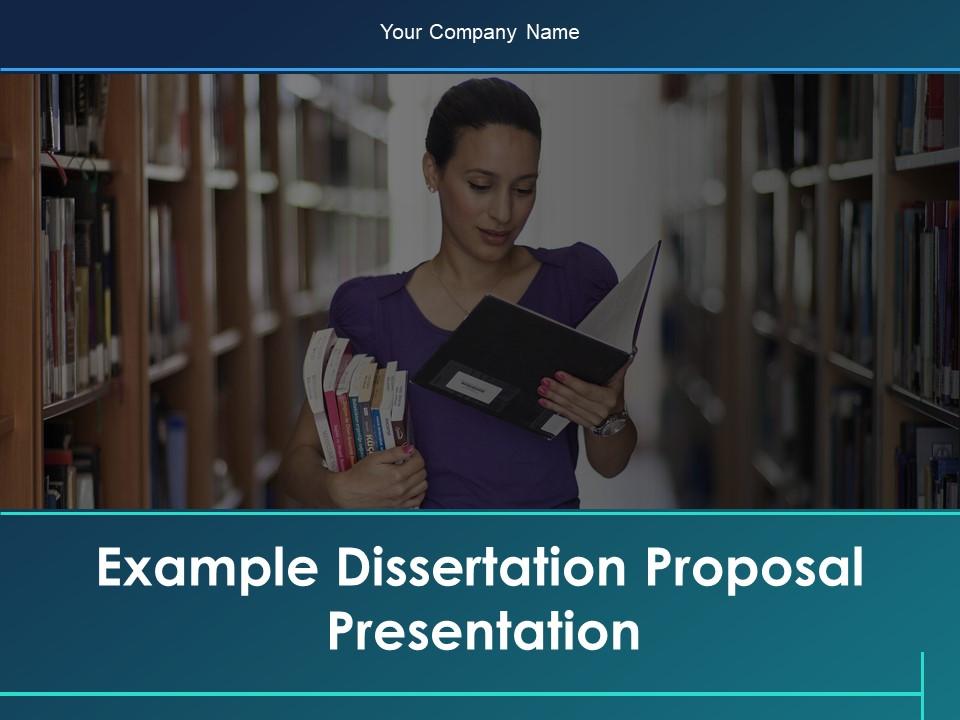
- Add a user to your subscription for free
You must be logged in to download this presentation.
PowerPoint presentation slides
Presenting Example Dissertation Proposal Presentation PowerPoint Presentation Slides. The deck contains a complete set of 44 high-resolution presentation slides. Users can edit PPT background, font, text, etc. You can download the presentation, in both widescreen (16:9) and standard (4:3) aspect ratio. From text to video, animation to logo insert anything. The PPT templates are compatible with Google Slides, PDF and JPG formats.

People who downloaded this PowerPoint presentation also viewed the following :
- Business Slides , Flat Designs , Strategic Planning Analysis , Complete Decks , All Decks , Process Management , Strategic Management , Proposal
- Example Dissertation Proposal Presentation Ppt ,
- Essay Proposal ,
- Thesis Proposal
Content of this Powerpoint Presentation
Example dissertation proposal presentation powerpoint presentation slides with all 44 slides:.
Our Example Dissertation Proposal Presentation Powerpoint Presentation Slides are innately eco-friendly. Their high recall value negate the need for paper handouts.

Ratings and Reviews
by Chi Ward
July 8, 2021
by Columbus Vasquez
July 7, 2021

Got any suggestions?
We want to hear from you! Send us a message and help improve Slidesgo
Top searches
Trending searches

welcome back
85 templates
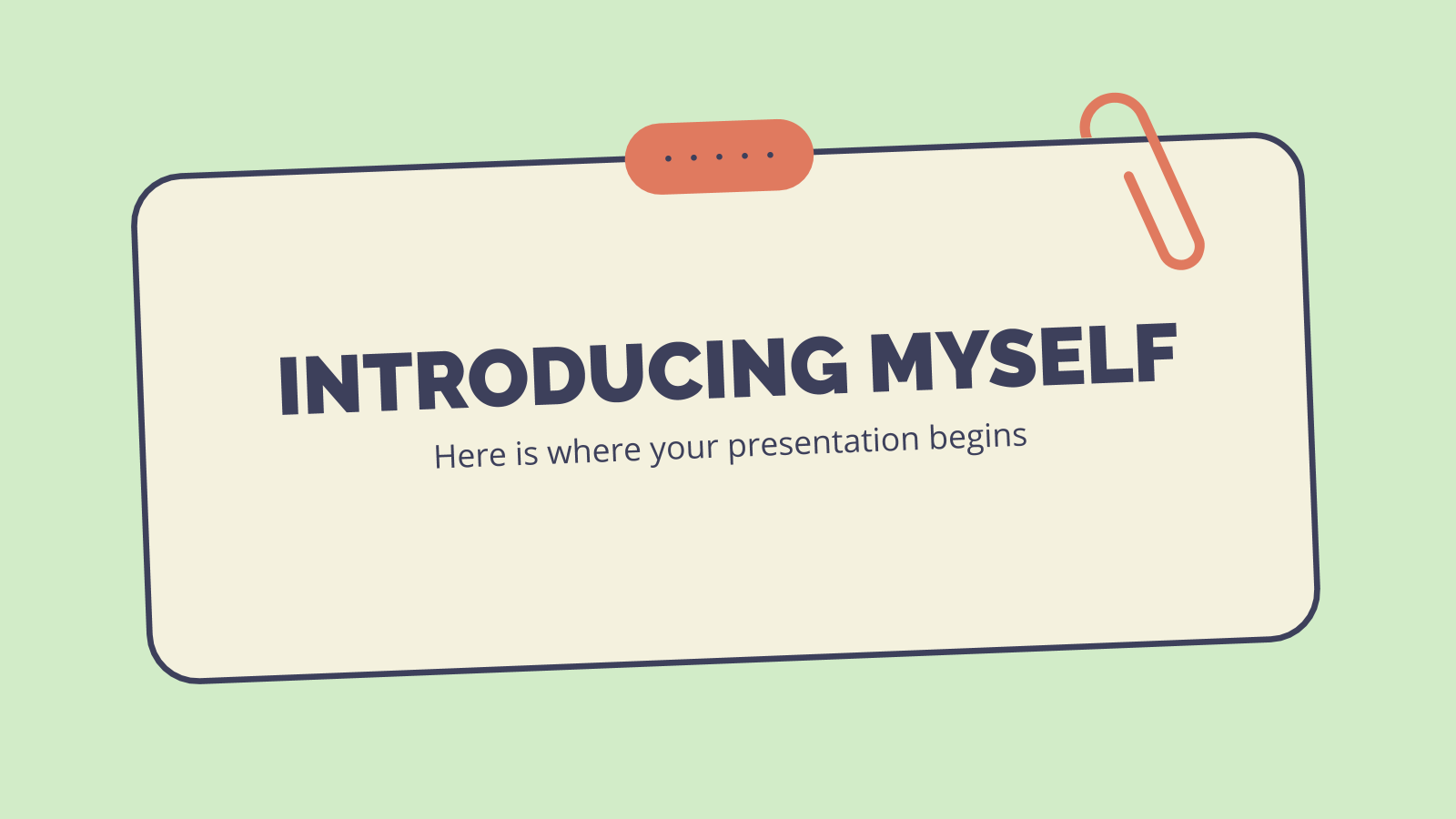
178 templates

earth science
84 templates

meet the teacher
31 templates

112 templates

composition notebook
34 templates
Research Project Proposal
It seems that you like this template, research project proposal presentation, premium google slides theme, powerpoint template, and canva presentation template.
Before embarking yourself on a new project, especially if it’s about research, you need to set out a proposal to explain its viability. Here at Slidesgo we’re offering this theme that you can actually use for any kind of project, regardless of the topic.
We’ve designed this template very carefully so that it can work in any context. For example, our flat illustrations, while visually appealing, show generic business situations, so versatility is on your side. The white backgrounds contain various gray objects on top of them as decorative elements, such as windows or filing cabinets. Our customizable layouts are useful for displaying things like project goals, results, timelines and mockups. The graphic resources and the typography focus on the green and dark blue colors, which are always synonyms for security and growth. Ready to edit this versatile business template?
Features of this template
- A versatile business template with flat illustrations related to a generic office context
- 100% editable and easy to modify
- 26 different slides to impress your audience
- Available in six colors: green, pink, purple, blue, yellow, and red
- Contains easy-to-edit graphics and maps
- Includes 500+ icons and Flaticon’s extension for customizing your slides
- Uses illustrated concepts from Storyset : editable color, different backgrounds, animated illustrations
- Designed to be used in Google Slides, Canva, and Microsoft PowerPoint
- 16:9 widescreen format suitable for all types of screens
- Includes information about fonts, colors, and credits of the free and premium resources used
What are the benefits of having a Premium account?
What Premium plans do you have?
What can I do to have unlimited downloads?
Combines with:
This template can be combined with this other one to create the perfect presentation:

Don’t want to attribute Slidesgo?
Gain access to over 29500 templates & presentations with premium from 1.67€/month.
Are you already Premium? Log in
Available colors
Original Color

Register for free and start downloading now
Related posts on our blog.

How to Add, Duplicate, Move, Delete or Hide Slides in Google Slides

How to Change Layouts in PowerPoint

How to Change the Slide Size in Google Slides
Related presentations.

Create your presentation Create personalized presentation content
Writing tone, number of slides, premium template.
Unlock this template and gain unlimited access

Register for free and start editing online
Home Blog Business How to Create Engaging and Persuasive Proposal Presentations
How to Create Engaging and Persuasive Proposal Presentations
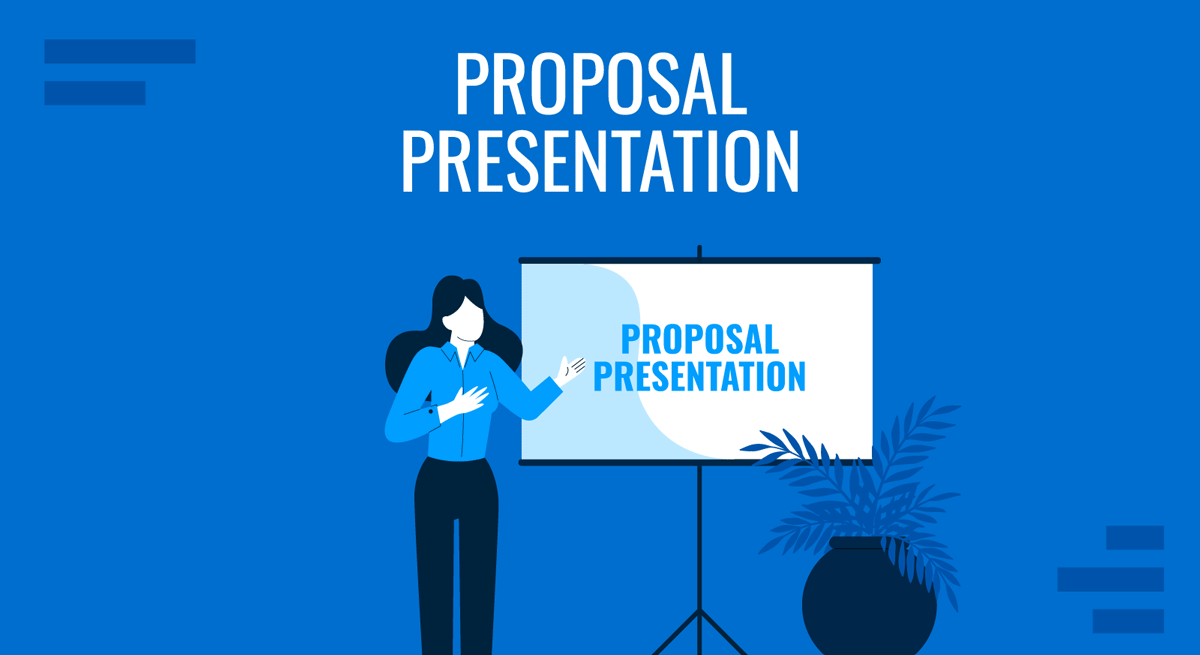
Whether you’re pitching a new project to stakeholders, seeking investment from potential backers, or presenting a solution to a client, the success of your proposal hinges on your ability to convey your ideas clearly and convincingly. It’s not enough to count on flashy graphics: the presenter must understand how to communicate ideas in the same business language as their target audience.
This article explores the critical components of a successful proposal presentation, providing you with practical insights and strategies to craft and deliver a compelling pitch. From understanding the core elements and structuring your presentation to delivery techniques, this comprehensive guide will equip you with the tools you need to make your proposal stand out and achieve your business objectives.
Table of Contents
What is a Proposal Presentation?
What makes a great proposal presentation, elements of a proposal presentation, how to start a proposal presentation, tips for delivering the proposal presentation, how to end a proposal presentation, recommended ppt templates for proposal presentations, final words.
A proposal presentation is a communication framework aimed at convincing an audience to adopt a certain idea, plan, or project. It serves as a persuasive tool to pitch products, services, or concepts to potential clients, investors, or stakeholders. A business proposal presentation often incorporates data, case studies , and visuals to build a compelling argument, making it an essential aspect of business development and strategic planning .
A great proposal presentation is clear, concise, and compelling. It captures the audience’s attention, holds their interest, and convincingly presents the proposed solution’s benefits. The following attributes contribute to a successful presentation:
Avoid jargon and overpopulated sentences that might confuse your audience. Use straightforward language to ensure your message is easily understood. If you need to introduce a complex concept in your presentation, work your way through graphics and try to simplify ideas as much as possible.
A well-thought presentation structure guides the audience through the proposal logically. It should start with an introduction that outlines the purpose, followed by a detailed discussion of the problem, proposed solution, implementation plan, and expected benefits.
Visual Appeal
Visual elements such as charts or graphs , images, and videos can enhance understanding and retention. To maintain a polished look, use a consistent and professional design for your slides.
Tailor your content to the audience’s needs and interests. Address their pain points and demonstrate how your proposal provides a solution. Use relevant examples and case studies to support your arguments.
Engage your audience with questions, interactive presentation elements, and storytelling . Personal anecdotes or client testimonials can make your presentation more relatable and persuasive.
In order to create a winning proposal presentation, we must count with the following elements.
Title Slide
This is the audience’s first impression. It sets the context and tone for the entire presentation and must feature a professional and polished look.
Clearly state the presentation title, your name, and the company’s name. If relevant, add a date, but it’s not absolutely required. Branding presentation elements like logo, colors, and fonts need to remain consistent to reinforce your company’s identity. You can use a pertinent image or graphic to the presentation topic (i.e., if it’s a product presentation , a product photo highlighting your product) to make the slide more visually appealing.
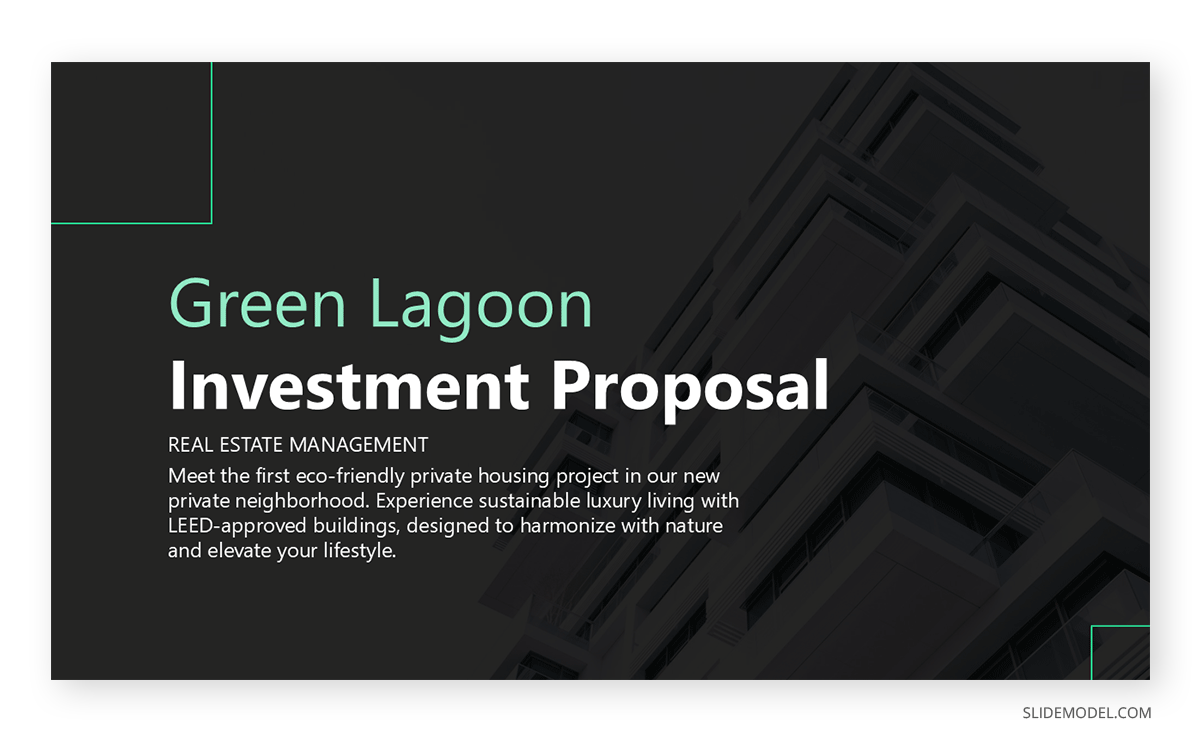
Avoid cluttering the slide with too much text. Any secondary information, like what the presentation is about, belongs on the introduction slide. Complex animation effects may deter the audience’s focus and render your slide deck amateurish.
Another common mistake is to use poor font pairing choices, e.g., script fonts with poor readability or low-sized texts.
Introduction Slide
Here, we provide the audience with an overview and context for the proposal, outlining the problem or opportunity. Factual information like financial data , surveys, or any kind of data presentation that can back up your problem statement is relevant. Remember to deliver a teaser of the full problem or opportunity, as that information is bound to be expanded in the next slide.
Explain the purpose of your proposal and what you aim to achieve. This will give the audience a clear understanding of the presentation’s objective from the outset. However, you should avoid ambiguous statements that can confuse the audience.

Problem Statement Slide
Clearly defining the problem or opportunity is essential for establishing the need for your proposal. It helps the audience understand the context and significance of your proposal. A well-articulated problem statement sets the stage for your proposed solution and underscores the urgency or importance of addressing the issue.
Support your statement with data, statistics, and real-world examples to illustrate the problem’s impact. Data adds credibility and helps quantify the issue. Additionally, we can make the problem relevant to the audience by linking some of its key points to their experiences or interests. This is a social proof of how the problem affects them directly or indirectly.
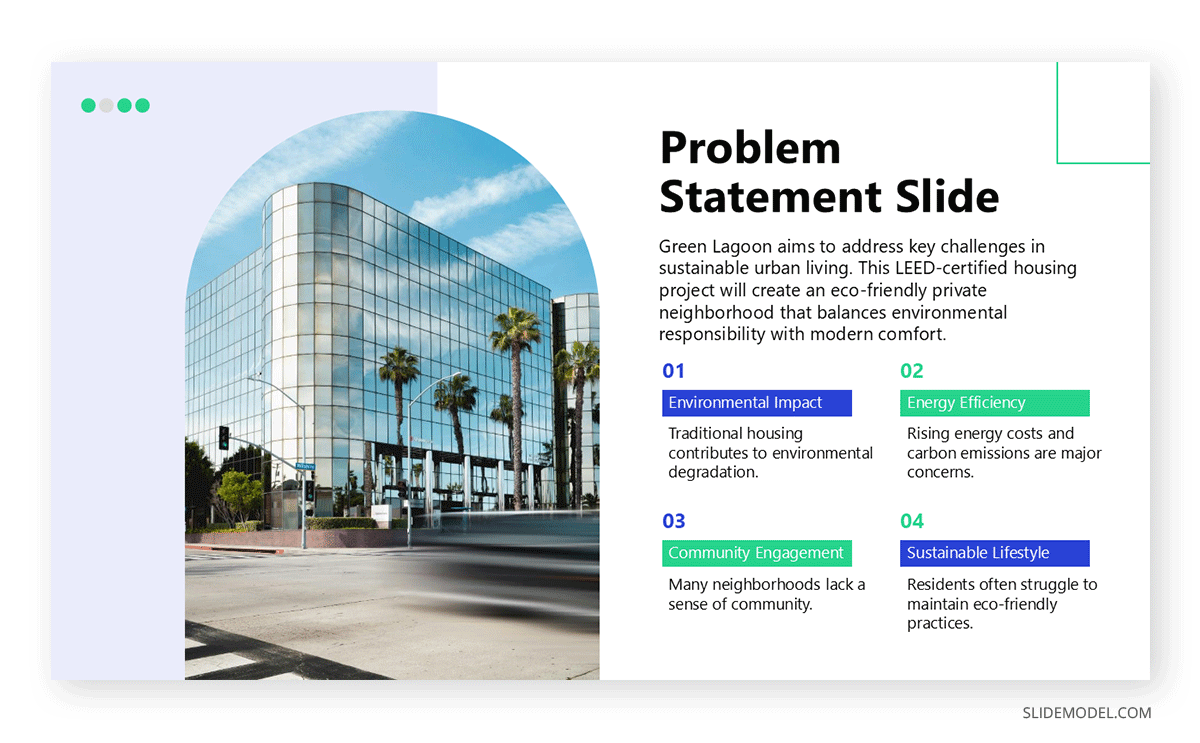
Compare the current situation with industry benchmarks or best practices to highlight the gap or deficiency. On this behalf, there are excellent presentation tools like gap analysis templates and comparison chart templates .
Proposed Solution Slide
The proposed solution is the core of your presentation, outlining how you plan to address the problem or seize the opportunity. This section is crucial for convincing the audience of your proposal’s feasibility and effectiveness. A coherently conveyed solution can demonstrate your expertise, innovation, and ability to deliver results.
Provide a detailed explanation of your proposed solution. Break it down into clear, actionable steps to help the audience understand how it works. Emphasize the solution’s benefits and competitive advantages . Explain how it will address the problem or capitalize on the opportunity. Diagrams, charts, and infographics are powerful tools to visually represent your solution without requiring lengthy walls of text in your slides. We invite you to check our article on how to present a project proposal for more strategies.

Don’t overlook possible challenges or limitations of your solution, as they are likely to come up in a Q&A session. Address them proactively and explain how you plan to mitigate them.
A good practice is to conduct a cost-benefit analysis to show the financial feasibility of your solution. Compare the costs involved with the expected benefits to demonstrate value for money.
Implementation Plan Slide
The implementation plan outlines the steps necessary to execute your solution, demonstrating feasibility and practicality. This section is key for convincing the audience that your proposal is not just theoretical but actionable and achievable. A detailed and realistic implementation plan can build confidence in your ability to deliver the proposed solution.
Outline the key steps, timelines, and resources needed to implement your solution. A detailed plan helps the audience understand what is required to bring your proposal to fruition. Identify major milestones and deliverables, as they provide a sense of progress and achievement, helping to keep the project on track.

Finally, develop a risk management plan to identify, assess, and mitigate potential risks. A robust risk management plan can enhance the audience’s confidence in your proposal.
Financials Slide
The financial section demonstrates the economic viability of your proposal. This section provides a detailed analysis of the costs involved, potential revenue, return on investment (ROI), and overall financial impact.
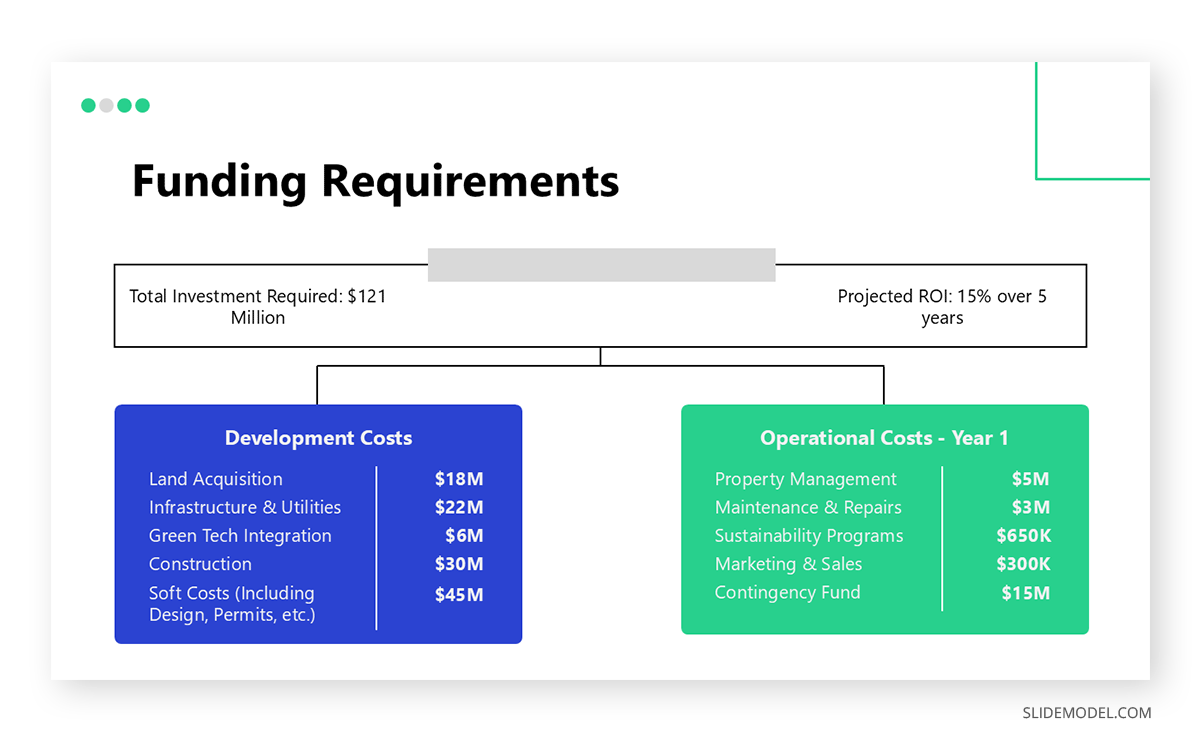
Don’t underestimate costs or overestimate revenues. Be realistic in your financial projections to maintain credibility. A break-even analysis is excellent for showing when the project will start generating profit, which boosts the perception of the proposal’s financial viability.
Conclusion Slide
The conclusion summarizes your presentation’s key points and reinforces your proposal’s value. It provides a final opportunity to persuade the audience and leave a lasting impression. A strong conclusion can help seal the deal and gain the support or approval needed for your proposal.
Recap the main points of your presentation, including the problem, proposed solution, implementation plan, and financials. Emphasize the benefits and value of your proposal and highlight the positive outcomes and advantages of your solution.
End with a clear call to action, specifying what you want the audience to do next. A call to action can include approval, funding, support, or any other desired outcome.

There are numerous ways on how to start a presentation , especially for proposals, but in our experience, it’s best to stick with a strong, attention-grabbing opening statement. You can pick from a surprising fact related to your problem statement, a compelling statistic, or even a thought-provoking question linked to your proposed solution.
An icebreaker can help relax the audience and make them more receptive to your presentation. For instance, you could share a relevant and engaging story or anecdote that ties into the theme of your proposal. A personal story can humanize you and make the presentation more relatable.
Another approach is to ask the audience a simple question that requires a show of hands or a quick verbal response. This encourages participation and makes the audience feel involved from the start.
Acknowledge the audience’s role or contributions with a personal touch. For in-company presentations, you can use a line similar to: “I know that many of you have been working tirelessly to improve our company’s performance, and I believe this proposal can help us achieve even greater success.” This creates a common ground with the audience, increasing their interest in what you have to say next.
Tip #1 – Voice Tone
Use pitch, tone, and volume variations to emphasize key points and maintain audience interest. Speak at a moderate pace, as speaking too fast can confuse the audience, whereas speaking too slow can lead to boredom.
Tip #2 – Use Silence Effectively
Working with pauses in your speech can help important points sink in. Silence in a presentation is a powerful tool for emphasis, and as a speaker, you can moderate it by introducing a 30-to-50-second pause after a mind-blowing fact about your proposal.
Tip #3 – Be Adaptable
Not all proposal presentations work alike. Be prepared to adapt your presentation if the situation calls for it, such as if you need to move forward with a Q&A session much sooner than you expected. Flexibility shows professionalism and command of your topic.
Tip #4 – Body Language
If space allows, move around the stage or presentation area with purpose. Avoid pacing or fidgeting, which is distracting and causes unease, lack of preparation, and lack of professionalism. Appropriate hand gestures can help emphasize points and convey enthusiasm as long as you don’t overdo it.
Try to stay relaxed and calm. Deep breathing techniques before and during the presentation can help manage anxiety.
Now it’s time to acknowledge how to end a presentation when working with business proposal presentations or any kind of professional-ranged proposal.
As we mentioned before, you need to clearly state what you want the audience to do next. This could be approving the proposal, providing funding, supporting the initiative, or any other specific action. Outline the steps required to move forward. Make it easy for the audience to understand what is needed from them.
Emotions are a persuasive factor in a conclusion. If you feel the proposal is likely to be accepted, paint a vivid picture of the future. Describe the positive outcomes and improvements that will result. Thank the audience for their time, attention, and consideration. Acknowledging their participation helps to build a positive relationship.
In this section, we selected some of our best Project Proposal PowerPoint templates to speed up your slide design process. Keep in mind you can test the Free Business Proposal PowerPoint Template and adapt it to your requirements.
1. Project Proposal Planning PPT Template

A compendium of tools to meticulously present any kind of project proposal is at one click of distance. It features an intro slide with relevant KPIs, objectives, scope, implementation timeline, resource allocation, risk assessment, and much more. Check it out!
Use This Template
2. Construction Painting Proposal PowerPoint Template

Ideal for contractors, architects, interior designers, or any construction professional who needs to deliver a construction proposal to a prospective client, A slide deck listing 15 easy-to-edit slides in a clean layout.
3. Sponsorship Proposal PowerPoint Template

This minimalistic slide deck is intended for companies seeking to seal sponsorship deals. It contains all the required tools to discuss sponsorship tiers, benefits, target audience, deliver past experience testimonials, etc.
4. Legal Services Proposal PowerPoint Template
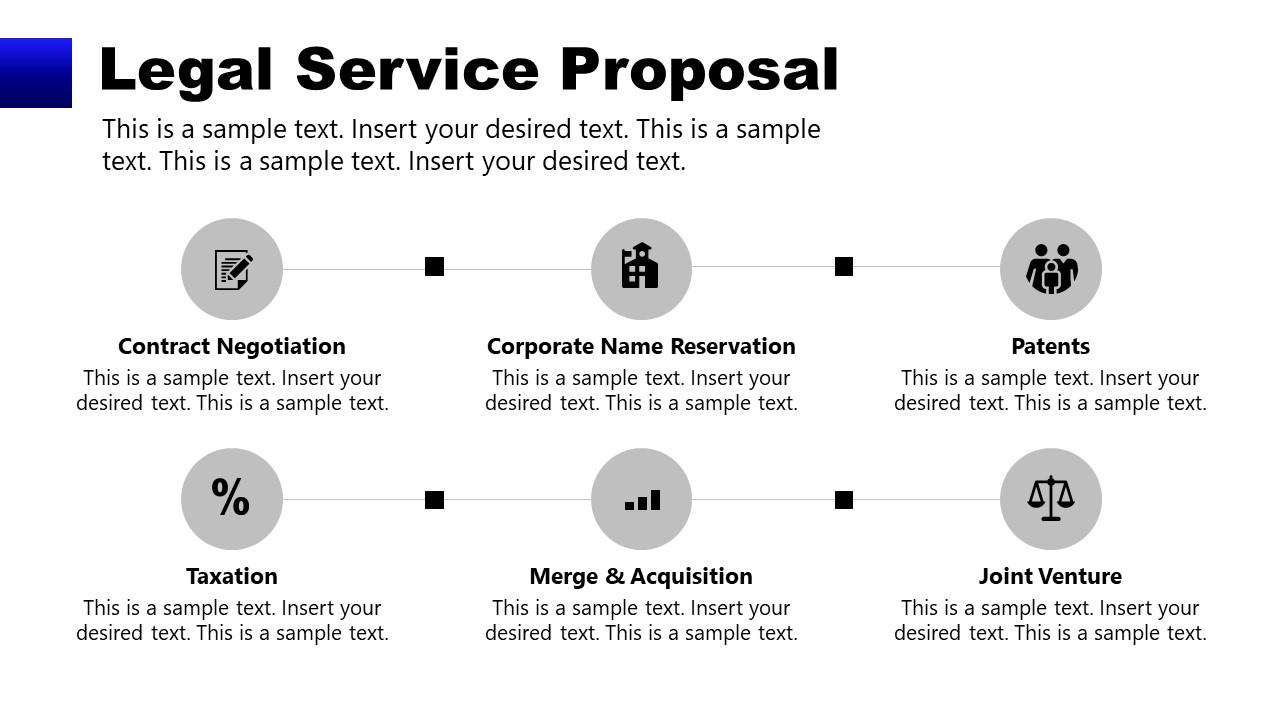
For any law firm that wants to power up its game, this proposal presentation slide deck reduces the need for lengthy text paragraphs in slides in favor of easy-to-remember icons with placeholder text areas next to them.
5. SEO Proposal Slide Deck for PowerPoint

Digital marketing professionals can learn how to present a proposal by using this creative slide deck. In a sleek blue-to-green gradient and white color scheme, the 18 slides available in this proposal PPT template offer a broad range of tools to create a winning proposal presentation.
Crafting an effective proposal presentation requires meticulous planning and strategic execution. Each element must be well-organized and clearly articulated, from a compelling opening to a persuasive conclusion. By following the methodology shown in this article, you can enhance your proposal’s impact, build credibility for your brand, and increase the likelihood of securing support from your audience, whether they are investors, clients, or internal stakeholders.
Like this article? Please share
Business Ideas, Business Presentations Filed under Business
Related Articles

Filed under Presentation Ideas • June 28th, 2024
Key Insights on How To End a Presentation Effectively
Learn key insights on how to end a presentation, with professional tips, PowerPoint templates examples and real life experiences.

Filed under Business • June 12th, 2024
How to Master Roadshow Presentations
Get to know a how to approach a roadshow presentation and deliver a winning speech. A guide for roadshow presentation slides, with recommended tools.
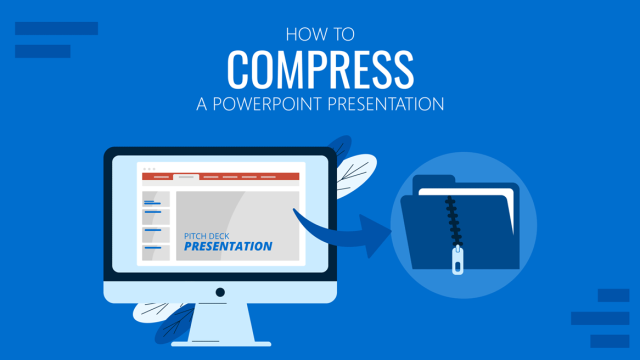
Filed under PowerPoint Tutorials • May 28th, 2024
How to Compress PowerPoint Presentations
You don’t need to end up with gigantic PowerPoint files you cannot email or distribute with ease. Instead, learn how to compress PowerPoint presentations by applying any of these 6 different methods.
Leave a Reply
Proposal Outlining: A Guide for Getting Started

Have you ever felt the sting of presenting a project proposal only to watch it fall flat? Despite pouring your heart and soul into it, all you get back are crickets and cleared throats. The reality is that crafting a proposal that captivates and convinces isn't a matter of effort alone—it's about strategy. And that strategy starts with a well-structured outline.
In this article, we'll unlock the secrets of an effective proposal outline and explore the elements that make a proposal not just good but remarkable. This first step will help you to align your ideas with your client's needs.
Key takeaways
- A good proposal outline can help you organize your ideas and the key points you need to make to persuade your prospect.
- Each part of the proposal outline should serve a specific purpose
- You might want to share your proposal outline with a peer or even your prospect to ensure it covers all of the critical information your proposal will need
What is a proposal outline?
A proposal outline is a framework that organizes your ideas and pitches into a coherent structure, ensuring every crucial element of your proposal is considered and clearly presented. It’s the backbone of your proposal, guiding you from the introduction to the conclusion, ensuring a logical flow and that no key points are missed.
A well-crafted proposal outline consists of several parts, each serving a specific purpose:
- Introduction : Sets the stage, introduces the problem or need, and captures interest.
- Problem Statement : Clearly defines the issue that your proposal aims to solve.
- Solution Overview : Outlines your proposed solution and its benefits.
- Deliverables and Timelines : Specifies what will be delivered and when .
- Cost Estimate : Provides a clear and detailed breakdown of costs associated with the proposal.
- Conclusion : Summarizes the proposal, reinforcing the value and feasibility of your solution.
By using a proposal outline, you ensure your proposal is not only complete but also tailored to directly address the needs and concerns of your clients. There is also a good selection of proposal software (and even proposal templates ) to help you futher speed up and scale the process here. In fact, we might know a few people ourselves…
Importance of outlining
Why spend extra time on a proposal outline? Well, outlining isn't just about organizing your thoughts—it's about setting a strategic foundation for your proposal. Here’s why it’s absolutely crucial:
- Enhances clarity and focus : An outline keeps your proposal focused on the client’s needs and your solution. It prevents you from veering off-topic and ensures every part of the proposal pushes toward the end goal—securing approval.
- Saves time in the long run : It might seem like extra work at the start, but having a clear outline actually speeds up the writing process. You know exactly what to write about in each section, cutting down on revisions and rewrites.
- Improves persuasiveness : A structured proposal is a persuasive proposal. With all points logically flowing from one to the next, your argument builds momentum- and with it, a compelling case to your client.
- Facilitates collaboration : When working in a team, an outline acts as a shared plan. Everyone knows their part, reducing overlap and ensuring all necessary points are covered.
- Makes a professional impression : A well-organized proposal reflects professionalism and attention to detail. It shows potential clients that you are thorough and capable, boosting their confidence in your abilities.
In short, an outline isn’t just a planning tool—it’s a critical element that elevates the quality and effectiveness of your proposal. By taking the time to outline, you're paving the way for a smoother, more impactful presentation that aligns perfectly with your client's expectations.
Key elements of a detailed project proposal outline
Crafting a project proposal is like telling a story where you're the hero who can solve the client's problem. To tell this story effectively, you need several key elements, communicating your understanding, plan, and commitment to the project's success. These elements are:
- Introduction
Kick off your proposal by grabbing attention. Introduce the problem and hint at the solution, making sure to connect emotionally (and logically) with your potential client.
- Problem statement
Dive deep into the problem. Demonstrate your understanding of the client's needs and challenges. Show empathy and expertise, making it clear why this issue needs resolution.
- Solution overview
This is where you shine. Outline your proposed solution and the unique benefits it offers. Be clear and concise , using simple terms that convey value and feasibility.
- Objectives and goals
Define what success looks like. Detail the objectives your solution aims to achieve, aligning them closely with the client’s requirements.
- Methodology and approach
Explain how you plan to achieve the outlined objectives. This section should reassure the client of your method's effectiveness and your team's capability.
- Deliverables
Specify what you will deliver, including tangible products, reports, and results. This sets clear expectations and helps avoid scope creep.
Map out the project timeline. Include key milestones and deadlines to demonstrate your project management skills and realistic approach.
- Cost estimate
Provide a detailed breakdown of the project cost. Transparency here builds trust and helps the client understand the value they are getting.
Wrap up with a strong conclusion that reiterates the benefits of your proposal. Encourage the client to take action, and make it easy for them to say Yes.
By including these elements, your proposal will not only be comprehensive but also tailored to clearly communicate how you are the best choice for the project.
How to create the perfect proposal outline (then fill it in)
Creating the perfect proposal outline is like preparing a recipe that’s tailored to taste—it needs the right ingredients, a pinch of creativity, and a good understanding of who's going to enjoy it! Here’s a simple, effective way to put it all together:
Step 1: Understand the client’s needs
Begin by thoroughly researching your client’s industry, challenges, and specific needs. The more you know, the better you can tailor your proposal to speak directly to them. Dive into their company reports, read relevant industry news, and analyze their competitors. This groundwork enables you to address their unique pain points with precision.
Step 2: Define the project scope
Clearly define what the proposal will cover and- importantly- what it won’t. Setting these boundaries early prevents misunderstandings and keeps your proposal laser-focused.
Step 3: Gather your data
Collect all the necessary information, data, and resources that will support your solution. This could include case studies, testimonials, or relevant statistics that reinforce your points. Solid data not only backs up your claims but also builds credibility, showing that your solution is grounded in proven results and sound research.
Step 4: Draft the structure
Using the key elements outlined above, start drafting your proposal. Arrange the sections in a logical order that tells a compelling story, from problem to solution. Each section should naturally lead into the next, creating a seamless narrative that keeps the reader engaged and makes your argument compelling.
Step 5: Write the details
Fill in each section with detailed information. Ensure your writing is clear, persuasive, and directly addresses how you will solve the client’s problem. Use active language, avoid jargon, and be specific about the benefits of your solution. Remember, the goal here is to make it easy for the client to understand and see the value in your proposal.
Step 6: Review and refine
Step back and review your proposal as a whole. Does it flow logically? Is it persuasive? Ask a colleague to proofread it for clarity and coherence. A fresh set of eyes can catch errors you might have missed and provide valuable feedback to improve the overall quality of the proposal.
Step 7: Customize your presentation
Tailor the final document to the client’s preferences. Consider their company culture and the decision-maker’s personal style when finalizing the format and tone. Customization shows you’ve taken the time to understand their business and care about their unique context, making your proposal stand out from more generic submissions.
Step 8: Include a Call To Action
End with a clear, compelling call to action. What do you want the client to do next? Make it easy for them to take the next step, whether it’s scheduling a meeting, signing a contract, or simply getting in touch. A strong CTA helps to turn interest into action, guiding the client towards a positive decision.
By following these steps, you’ll create a proposal outline that not only meets the client’s needs but also highlights your capabilities and understanding of their challenges.
6 Top tips for outlining proposals
Here are some top tips to ensure your proposal outlines set you up for success:

Tip 1: Start with a strong hook
Capture your reader's attention from the outset. Use a compelling fact, question, or statement that speaks directly to the reader's interests or pain points.
Tip 2: Keep the client central
Always tailor your proposal outline with the client in mind. Every section should reflect an understanding of their needs, goals, and preferences.
Tip 3: Use clear, concise language
Avoid jargon and complex language. Your proposal should be easy to understand, making the client feel confident about what you’re offering. Simple language helps to ensure your message is clear.
Tip 4: Visualize the flow
Before writing detailed content, visualize how each section flows into the next. A logical, intuitive flow keeps the reader engaged and makes your arguments more persuasive.
Tip 5: Highlight key benefits
While detailing the features of your solution is important, focusing on the benefits for the client can be even more persuasive. Make it clear how your proposal will solve their problems or improve their situation.
Tip 6: Be realistic and honest
Set realistic expectations about what you can deliver and when. Honesty builds trust and reduces the chance of client dissatisfaction down the line.
By implementing these tips, your outlines will lay the foundations for a proposal that is hard to resist.
SaaS Proposal Template
Propel your business forward with our SaaS Proposal Template – present a persuasive case for adopting your solution to prospects.

Final thoughts
We've delved into the nitty-gritty of creating a persuasive proposal outline, focusing on clarity , structure , and a client-centered approach. Your proposal's true power lies in how effectively it addresses your client's needs and highlights your unique solution.
But why stop there? With Qwilr's innovative tools and templates , you can transform your outlines into visually stunning, interactive documents that captivate and convince. If you’re ready to gain a competitive edge and make your proposals irresistible, check out what Qwilr can do for you.
About the author

Marissa Taffer | Founder & President of M. Taffer Consulting
Marissa Taffer is the Founder & President of M. Taffer Consulting. She brings over 15 years of sales and marketing experience across various industries to a broad range of clients.
Frequently asked questions
What's the ideal length for a proposal.
The length of your proposal should be determined by the complexity of the project and the client’s requirements. Generally, aim for clarity and concision.
How much detail should I include about costs?
Provide a detailed breakdown of costs, including all relevant expenses. Transparency here is crucial—clients appreciate knowing exactly what they are paying for and why.
Can I reuse parts of an old proposal for a new client?
While you can reuse generic sections like your company overview, always tailor the proposal to each client’s specific needs and circumstances to show that you’ve crafted a solution just for them. Proposal automation software can help speed up the more generic aspects.
What if the client asks for changes to the proposal?
Be open to feedback and willing to make adjustments. This flexibility can often strengthen the client relationship and lead to a more successful partnership.
How often should I follow up after submitting a proposal?
Follow up within a week of submission to show your enthusiasm and commitment. If you haven’t received a response, a gentle reminder every few weeks can keep your proposal top of mind.
Related articles
- All articles
- Sales management
- Sales techniques
- Sales enablement
- Customer success
- Product updates


IMAGES
VIDEO
COMMENTS
As part of the Ph.D. selection process, all students are required to present their Ph.D. proposal for approval to the Ph.D. Scrutiny Committee at the University. The goal of the Ph.D. proposal presentation and approval process is to receive constructive feedback on the proposal and ensure that the Ph.D. proposal is feasible and appropriate for ...
Therefore, in a good research proposal you will need to demonstrate two main things: 1. that you are capable of independent critical thinking and analysis. 2. that you are capable of communicating your ideas clearly. Applying for a PhD is like applying for a job, you are not applying for a taught programme.
The dissertation proposal is required for all doctoral students. It addresses 1) why the research is relevant, 2) the focus of the research, and 3) how the research will be conducted. Students prepare a written document and give an oral presentation to the supervisory committee. This template is to serve as a general outline for…
This template can be used by Ph.D. candidates from various fields who are preparing for their Ph.D. registration. Slide 1: Title Slide. Title of the work. Candidate's name and affiliation. Supervisor's name and affiliation. Slide 2: Introduction. Briefly introduce the topic. Explain why the topic is important and relevant.
This Guide was created to help Ph.D. students in engineering fields to design dissertation defense presentations. The Guide provides 1) tips on how to effectively communicate research, and 2) full presentation examples from Ph.D. graduates. The tips on designing effective slides are not restricted to dissertation defense presentations; they can ...
When writing your PhD proposal you need to show that your PhD is worth it, achievable, and that you have the ability to do it at your chosen university. With all of that in mind, let's take a closer look at each section of a standard PhD research proposal and the overall structure. 1. Front matter.
6. PhD Dissertation Defense Presentation Template PhD Dissertation Defense Presentation Template. PhD Dissertation Defense Presentation Template features a clean, minimal design. It's well organized and easy to use. The only thing you need to focus on is your research. Unique slides: 21
Written by Mark Bennett. You'll need to write a research proposal if you're submitting your own project plan as part of a PhD application. A good PhD proposal outlines the scope and significance of your topic and explains how you plan to research it. It's helpful to think about the proposal like this: if the rest of your application explains ...
Detailed Walkthrough + Free Proposal Template. If you're getting started crafting your research proposal and are looking for a few examples of research proposals, you've come to the right place. In this video, we walk you through two successful (approved) research proposals, one for a Master's-level project, and one for a PhD-level ...
PhD Dissertation Defense Slides Design: Example slides. Start; Tips for designing the slides; Presentation checklist; Example slides; Additional Resources; Acknowledgments. Thank all Ph.D.s for sharing their presentations. If you are interested in sharing your slides, please contact Julie Chen ([email protected]). Civil and Environmental ...
The educational PowerPoint template of PhD dissertation contains 9 slides, with diagrams, charts, and shapes for describing your research and thesis. These PowerPoint templates will help prepare a compelling dissertation defense. The comprehensive slide deck of dissertation covers a structured approach of documentation.
A research proposal should present your idea or question and expected outcomes with clarity and definition - the what. It should also make a case for why your question is significant and what value it will bring to your discipline - the why. What it shouldn't do is answer the question - that's what your research will do.
A professional presentation template with a minimalist look and inspiring pictures. Includes 1000+ icons and Flaticon's extension for customizing your slides. Designed to be used in Google Slides, Canva, and Microsoft PowerPoint. 16:9 widescreen format suitable for all types of screens. Includes information about fonts, colors, and credits of ...
Simple, clean, and classic, these minimalist PhD dissertation slides are great as a Google Slides template, PowerPoint theme or Canva template. Keep the layout as it is or add, delete, and re-order slides. Choose your own color scheme and font combination. Upload images, photos, and illustrations. Easily add charts, graphs, and other figures.
Template 1: Abstract. This PPT Template allows you to prepare the foundation for your research proposal. Compile your opening thoughts in the slide. The purpose section of the research project will highlight the intent and aim. Use the design methodology to list the approaches that you plan to use while carrying out the research.
Download our research proposal template. Prevent plagiarism. Run a free check. Try for free ... In a PhD, students spend 3-5 years writing a dissertation, which aims to make a significant, original contribution to current knowledge. A PhD is intended to prepare students for a career as a researcher, whether that be in academia, the public ...
he spine of your proposal and later, in your thesis. The following fe. t. ps may help you to write your research questions:1. C. oose a topic that interests you and your readers.2. Make an investigation on your topic by going through scholarly jour. als and see what questions are raised by your peers. Take note of.
Research Proposal Presentation Template. Present your research proposal professionally and persuasively with this expertly designed template. Designed for clarity and impact, this template enables you to outline your research proposal in a structured and persuasive manner. Each section is carefully crafted to help you convince your audience of ...
Proposal Defense PowerPoint Template. The primary purpose of this defense is to propose methodology for answering your research questions. This document was created for educational purposes. Students are encouraged to discuss the expectations for the defense presentation with the EdD Dissertation Committee. Tips for Creating and Delivering an ...
Slide 1: This slide introduces Example Dissertation Proposal Presentation.State Your Company Name and get started. Slide 2: This slide shows Agenda.You can add the company agenda as per your requirement. Slide 3: This slide presents Thesis Presentation Outline with these nine points- Title Slide, Introduction, Purpose, Methods, Statistical Analysis, Results, Discussion, Conclusions, Reference ...
Features of this template. A versatile business template with flat illustrations related to a generic office context. Available in six colors: green, pink, purple, blue, yellow, and red. Includes 500+ icons and Flaticon's extension for customizing your slides. : editable color, different backgrounds, animated illustrations.
The format of the Dissertation Proposal will be decided by the Supervisory Committee. The student must present the proposal in a public seminar, but may also be required to provide the committee with a written proposal. All members of the committee must approve the proposal as indicated by signing the Thesis Proposal Approval form.
In a sleek blue-to-green gradient and white color scheme, the 18 slides available in this proposal PPT template offer a broad range of tools to create a winning proposal presentation. Use This Template. Final Words. Crafting an effective proposal presentation requires meticulous planning and strategic execution. Each element must be well ...
A proposal outline is a framework that organizes your ideas and pitches into a coherent structure, ensuring every crucial element of your proposal is considered and clearly presented. ... set of eyes can catch errors you might have missed and provide valuable feedback to improve the overall quality of the proposal. Step 7: Customize your ...